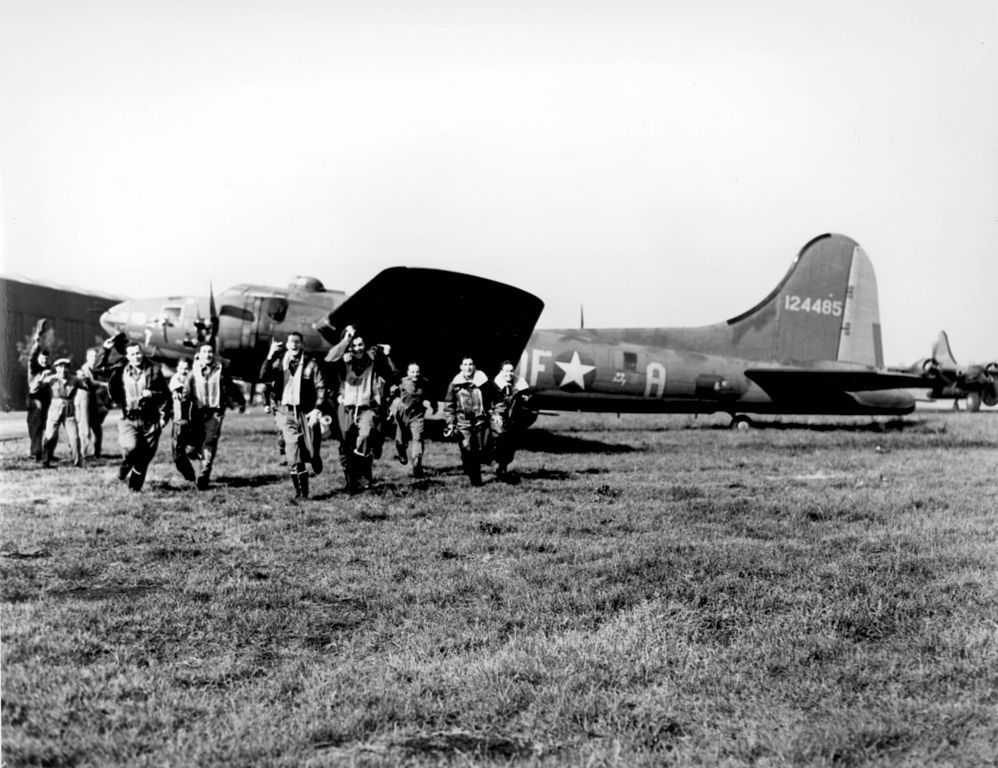
It seems appropriate that we would get the news on the anniversary of Memphis Belle’s final mission:
The Hangar Thirteen Foundation is now officially recognized by the US federal government as a 501c3 public charity.
We now have nonprofit status.
We have waited a long time for this and many have voiced their frustration about how long it has taken. Believe me, the feeling was mutual. We did as much as we could by ourselves but the IRS recommended we get help from a CPA to complete the final portion. This is what took so long.
But now it is done.
Donations to Hangar Thirteen are now tax deductible.
If you wish to contribute, the easiest way is through PayPal, our address being Store@HangarThirteen.org. We have not registered as a nonprofit with PayPal yet as, frankly, it is not a high priority. Regardless of nonprofit status, PayPal will always charge a fee (unless you are clever with how you send it). So, registering won’t change much. But we will get to it.
If you wish to have a receipt for your donation – be it financial or equipment – just let us know and we will write one up for you!
Keep the show on the road.
This year has been momentous so far. Hopefully it will continue to be so! This next bit of news is a certainly a big deal for us.
In January we were contacted by Nicholas Godfurnon of the Belgian Aviation Preservation Association (BAPA) about a local named Robert Bodart, who had approached them with a collection of pieces his father pulled from a B-17 during the war. This began the process of negotiating the sale of these parts. With the support of our followers, we were able to purchase Mr. Bodart’s collection, which was removed from “K-King” (44-6139, 351BG), a B-17G which crash-landed near Villers-lez-Heest on 12 September 1944.
BAPA built a crate for the pieces, tossing in a few B-25 parts for our friend Fred Bieser (the turret expert), and set up its itinerary through the Ziegler Group. On 9 June, the crate departed Brussels for Yateley, UK. From there, she trekked to London, Washington, DC, then Charlotte, North Carolina, where we planned for a local pickup.
I am sorry to say that that was was an adventure.
The tracking number stated that the crate arrived on 14 June aboard “Flight AL293” yet we were never contacted. Assuming that it was held up in customs, we waited. After a week, we started getting impatient. So we called Charlotte-Douglas International Airport. Nobody ever heard of a flight “AL293” – not customs, not the airport staff, not even American Airlines, the closest possibility.
Since we could not identify “AL293,” we turned to its previous carrier, as it went through Washington, DC via British Airways. Problem is, British Airways’ cargo branch, IAG Cargo, is nearly impossible to contact. After much searching, we finally found a number for their office at Dulles International Airport. An Indian man mumbled something in broken English and gave me a phone number to call. I called it and the man on the line laughed: “I don’t think you have the right number – we are a trucking company!”
Just the same, he typed in the tracking number and, lo-and-behold, the crate had been DRIVEN to Charlotte. “Flight AL293” was not a flight at all, it was a trucking company called Accelerated Courier. The man gave me a new tracking number and the phone number to the Charlotte office.
And nobody answered.
Days passed by and we finally got a response by writing their corporate office. E-mails back and forth quibbled over what papers and fees they required, with little explanation and even less attention to what we sent them. Getting exasperated, we called John S. James, a customs broker in Charlotte.
They were a HUGE help. In fact, I dare say that, if it were not for them, the crate may still be there.
Susanne Anderson, of John S. James, took up our case, gathering the documents required by Accelerated and personally driving down to the warehouse. Of course, there was no one at the office. So, on Tuesday, 29 June 2021, we drove to Charlotte to get our crate. Accelerated charged us $35 a dollars a day for the two weeks that they stored our crate. When we drove to their warehouse, there was finally someone there. They offered to refund the storage fees and gave excuses for why they had never called – despite my name, address, and phone number being pasted all over the box.
The guys here were pretty upset, but to be honest, I was just relieved that we finally had the crate.
Special thanks are due to Nicholas Godfurnon and Susan Anderson – thanks to your patience and hard work, we can restore these combat veteran pieces back to their former glory.

The crate from Belgium is driven out the Accelerated Courier warehouse.
Photo taken 29 June 2021.
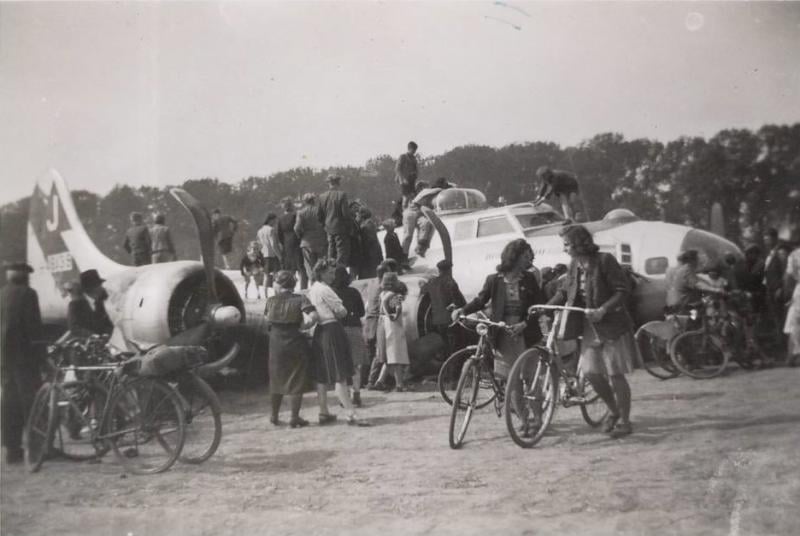
The wreckage of “K-King” (44-6139, 351BG), surrounded by locals.
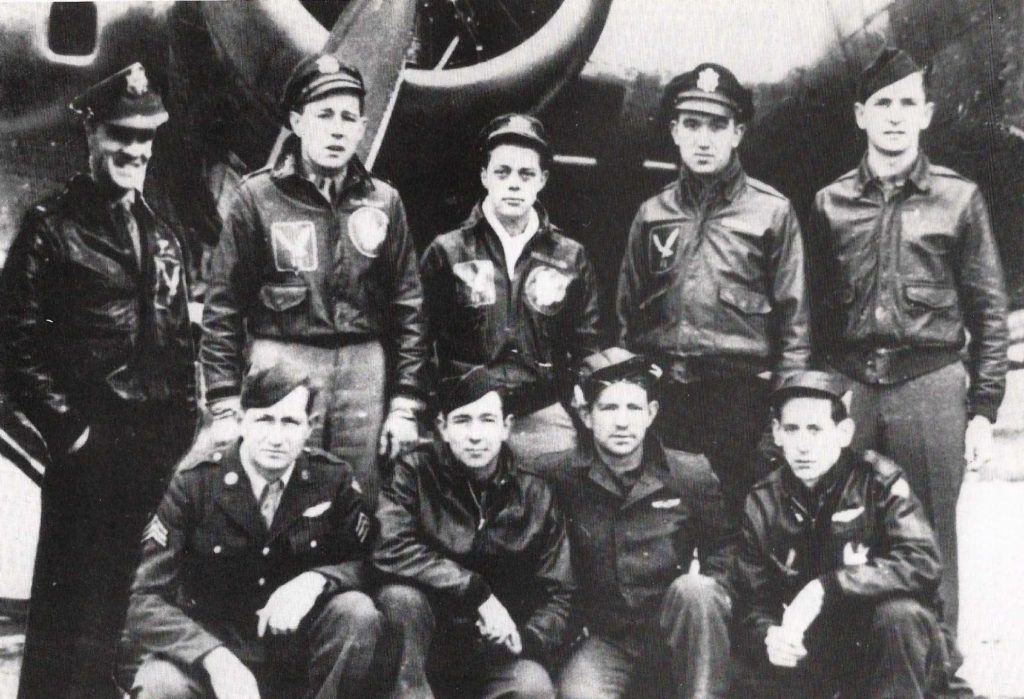
The crew of “K-King.”
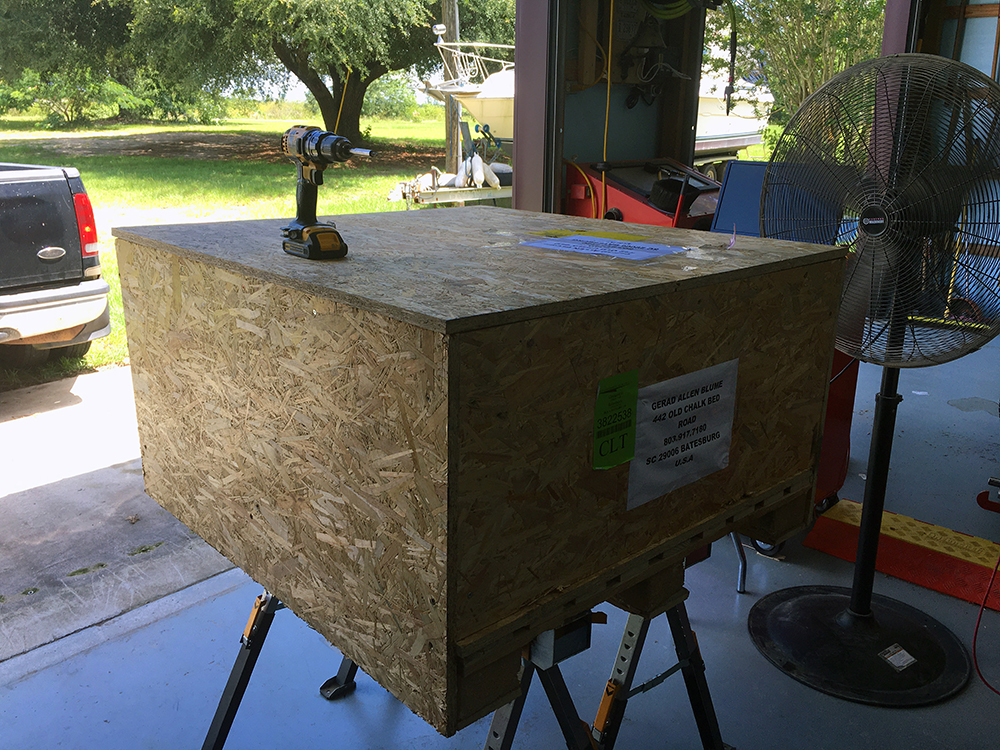
The crate from Belgium sits at my woodshop.
The weather in South Carolina is ungodly at this time of year. Temperatures around 92° F are bearable but the humidity is awful. The best way to describe it is to take a hot shower and immediately get dressed without drying off.
Photo taken 29 June 2021.
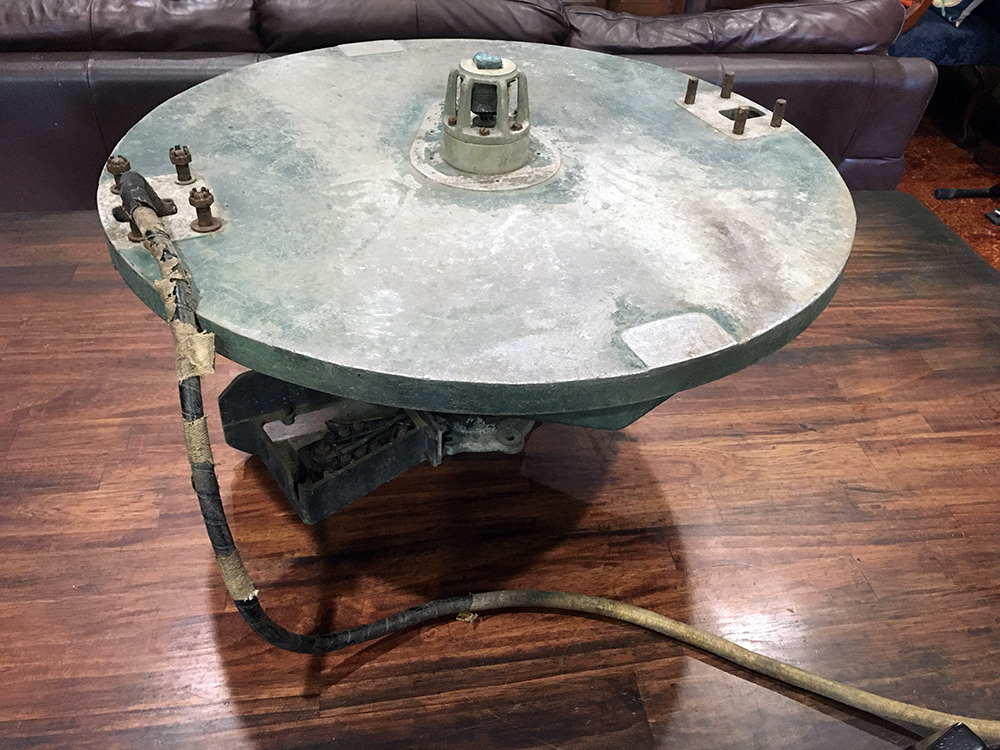
The top turret base assembly sits on my dining table.
It is in superb condition and even spins freely without any noise.
Photo taken 29 June 2021.
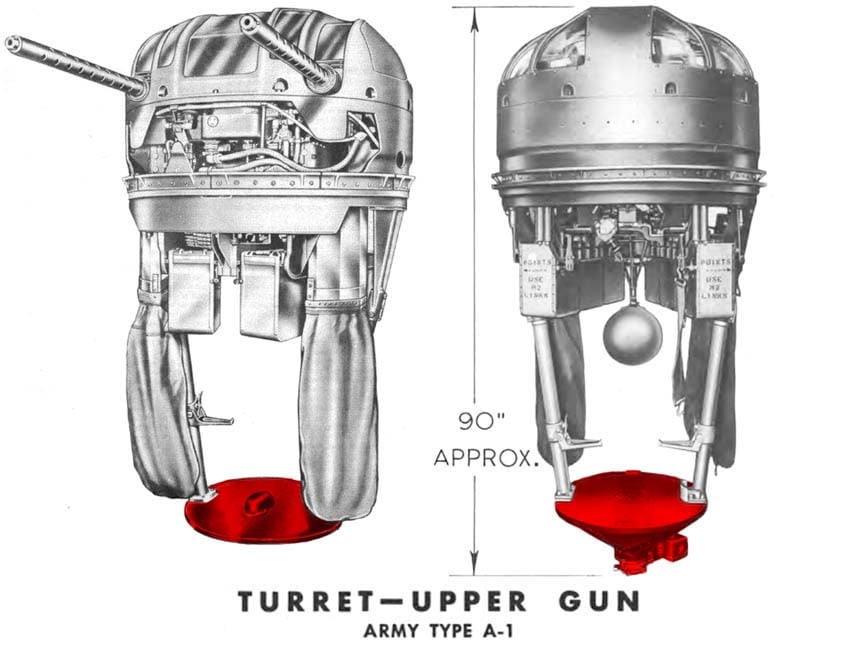
The base assembly for the B-17’s upper turret is highlighted in this manual illustration.
The base came in two variants, a flat one and one with a hump. Hump-type bases were for turrets who’s oxygen was taken from the aircraft’s system, whereas earlier turrets required their own bottle.
Interestingly, these bases are interchangeable, as Sperry Gyroscope (the designer of the turret), designed the turret knowing that it would eventually be altered to use the aircraft’s oxygen supply.


The ball turret junction box sits on my dining table.
We had always heard that Emerson ball turrets had green interiors and Briggs turrets unpainted interiors. Wartime photos certainly show both interior color schemes.
This piece contradicts that. Despite its Dark Dull Green color, this piece has a Briggs part number.
Photo taken 29 June 2021.
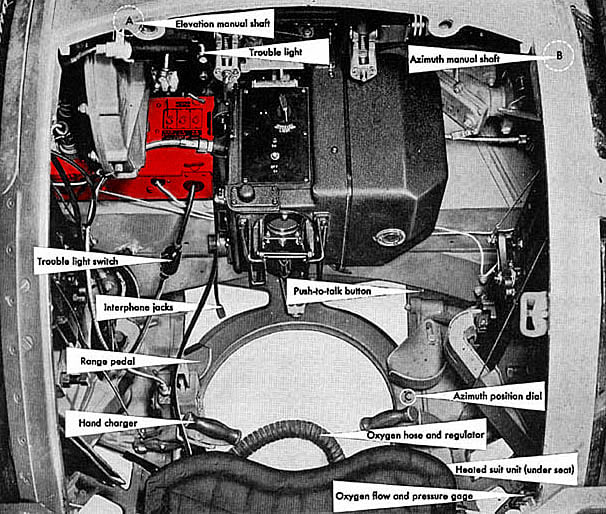
The ball turret’s electrical box is highlighted in this manual photo.
As evidenced by the light gray interior, this ball turret was supposedly built by Briggs Automotive Manufacturing.

The autopilot gyro from “K-King.” One can hardly describe how pristine this piece is. All it needs is to be plugged in!
Photo taken 29 June 2021.
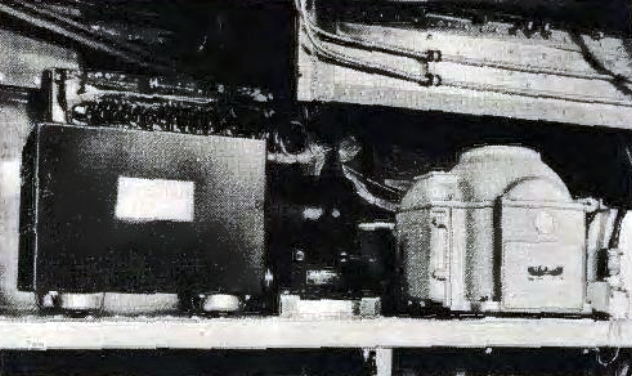
A manual illustration of the autopilot gyro.
The Honeywell C-1 autopilot was almost always used on heavy bombers in conjunction with the Norden bombsight. The gyro was placed in the aircraft’s center-of-gravity, opposite the entry hatch under the pilot’s seat. A series of three servos – pitch, roll, and yaw – were connected to the gyro so that, when activated, the gyro electrically pulled the servos so that the airplane remained in level flight.
Standard operating procedure also saw the autopilot activated whenever bailing out the of the airplane, as was the case for Lucky Thirteen when she was shot down over Beauvais, France on 6 September 1943.
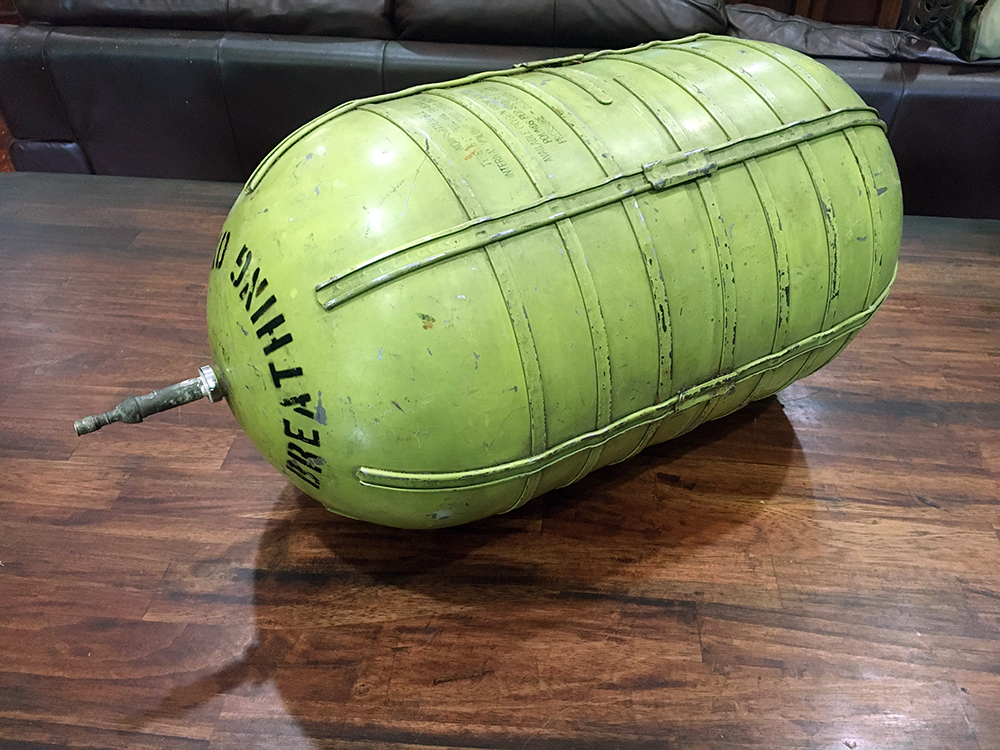
A Type G-1 oxygen tank pulled from “K-King.”
Photo taken 29 June 2021.
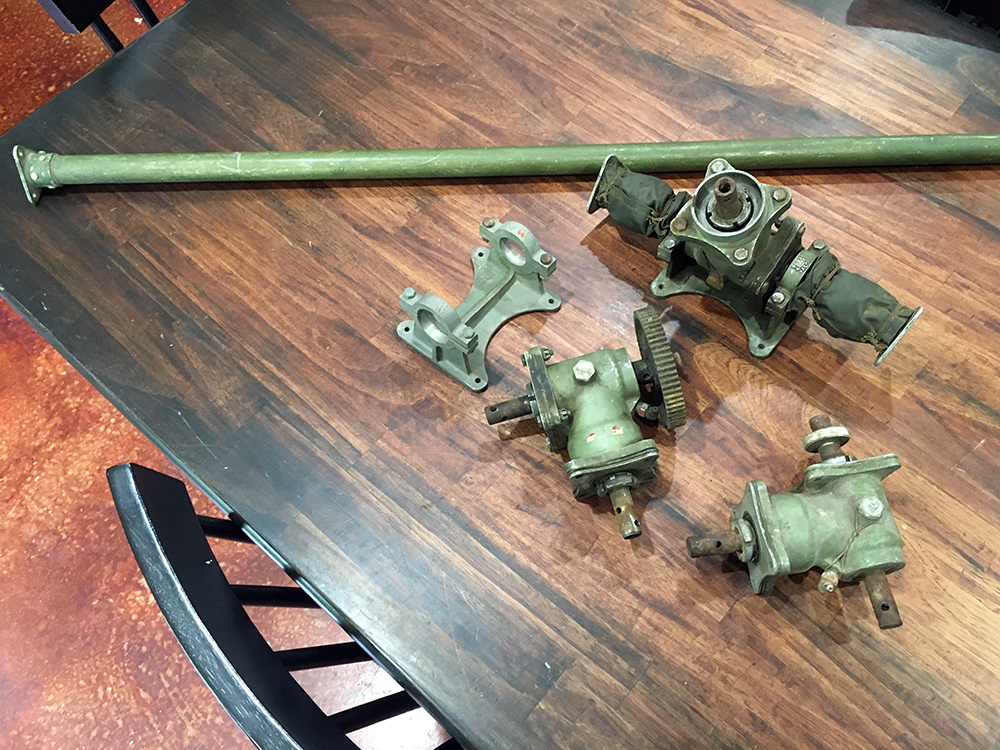
Flap control gears removed from one of the wings of “K-King.”
Photo taken 30 June 2021.
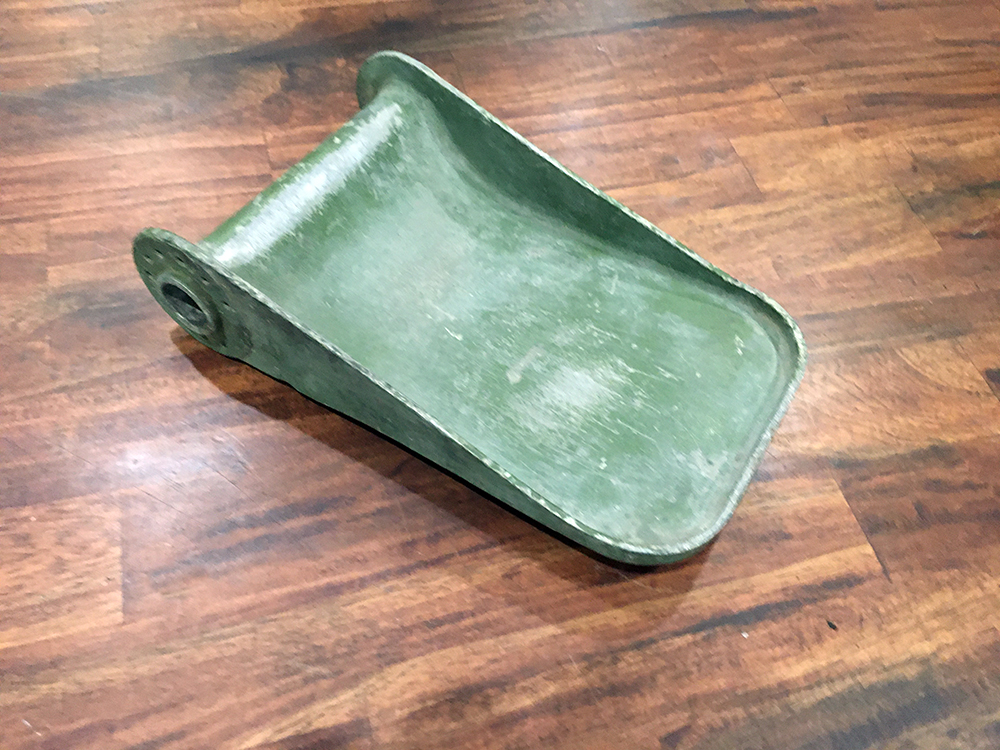
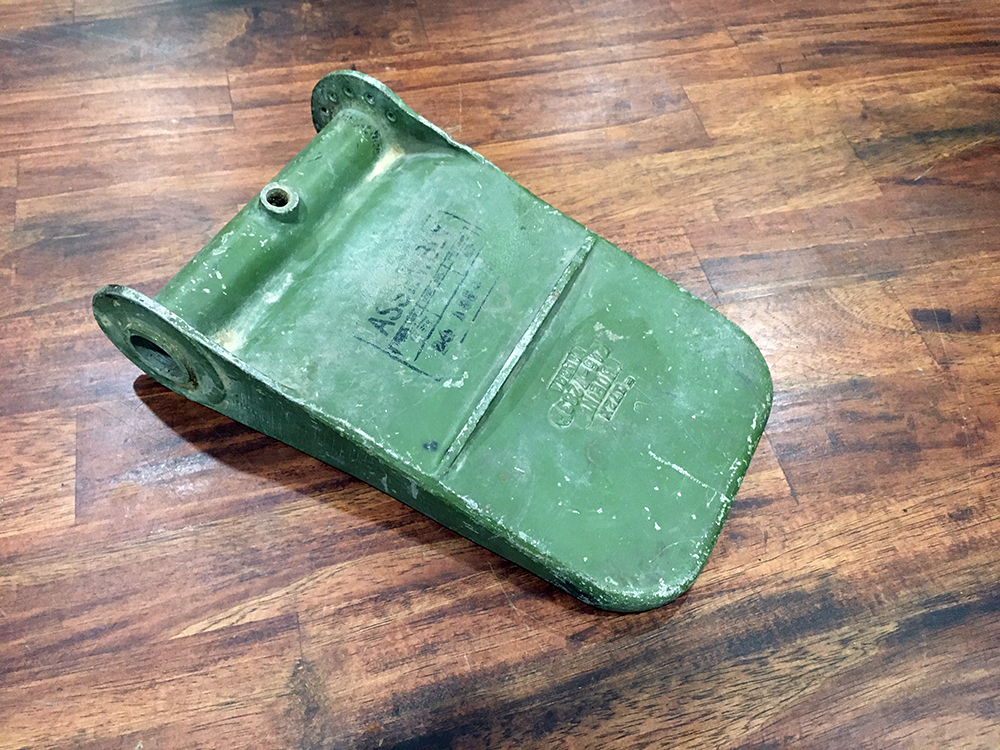
A rudder pedal from “K-King” sits on my dining table.
Photo taken 30 June 2021.
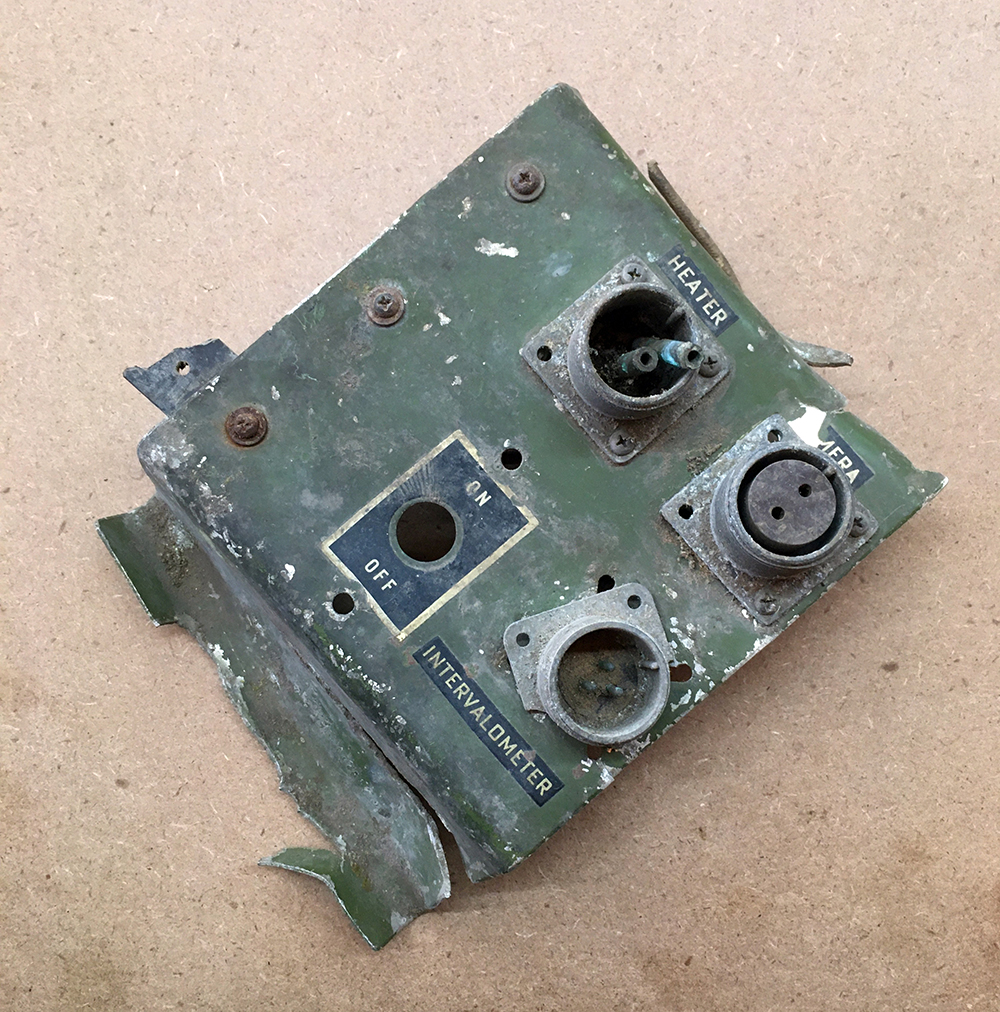
A piece of the strike camera control panel from “K-King.”
Photo taken 29 June 2021.

SSGT Bill M. Lyon and SSGT John A. Feairheller install the strike camera aboard Our Gang (42-5069, 91BG).
The strike camera was kept below the floor in the radio operator’s compartment of the B-17.
Our Gang was lost on 17 August 1943 during the infamous Schweinfurt/Regensburg strike. Said operation was Lucky Thirteen‘s third combat mission.
Here are some smaller bits that have recently come our way. They may be small but they are equally important to our goal of rebuilding the most high fidelity B-17 possible.
First is a Type A-2 Pyrotechnic Pistol Holder. This is a piece sought by several projects and we were fortunate that one of our followers, Ronald La Curan, alerted us to its listing. Thanks Ronald!
For most B-17s, the flare complement sat on a shelf on the back of the pilot’s seat. A Type A-7 Signal Flare Container was clipped to the shelf, with the Type A-2 Pyrotechnic Pistol Holder wrapped around the container. The A-7 held up to 18 signal flares while the A-2 held the AN-M8 Pyrotechnic Pistol.
Longtime followers might recall that Andy Rivera previously donated a beautiful wartime AN-M8 made by Eureka Vacuums. He also donated several original flares, including an early-war type made for the rare AN-M2 flare gun. In the interests of safety, we elected to make wooden blanks for the container.
It is truly amazing to finally have the factory flare setup for Lucky Thirteen. On 17 August 1943 – the infamous Schweinfurt/Regensburg strike – a 20 mm shell exploded in the waist compartment, wounding waist gunners SSGT John F. Schimenek and SSGT L. Corwin Miller while en route to the target. Schimenek was lightly scathed but Miller developed a serious chest wound. A second cannon shell started a small fuselage fire and Lucky Thirteen dropped out of formation after the bomb run. Schimenek wrapped Miller in blankets and watched his oxygen indicator for whenever Miller’s mask filled with blood, cleaning it out. Lucky Thirteen arrived at Grafton Underwood roughly 20 minutes prior to the rest of the group, firing a double-star red flare to indicate wounded aboard. Miller was awarded the Silver Star and Purple Heart for his actions, but Schimenek did not receive his Purple Heart until 1993 when comrades petitioned on his behalf.
Some other recent pieces that came in are a temperature gauge, some panel lights, and a pair of ammeters from Todd Blalock of Decatur, Alabama. Todd found out that we needed a globe-test switch for our instrument panel and also contributed one of those! Some of you may also remember when I offered the sale of our existing flight thermoses to pay for a pair we had located online. Well, here they are. We really wanted to get these for Lucky Thirteen as they still had their Army identification stamps on them.

The completed flare gun assembly for Lucky Thirteen.
Photo taken 20 June 2021.
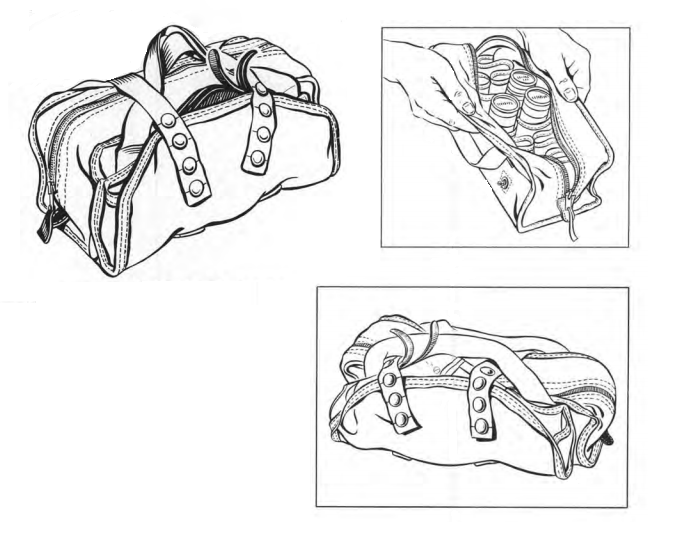
The Army index illustrations for the flare setup.
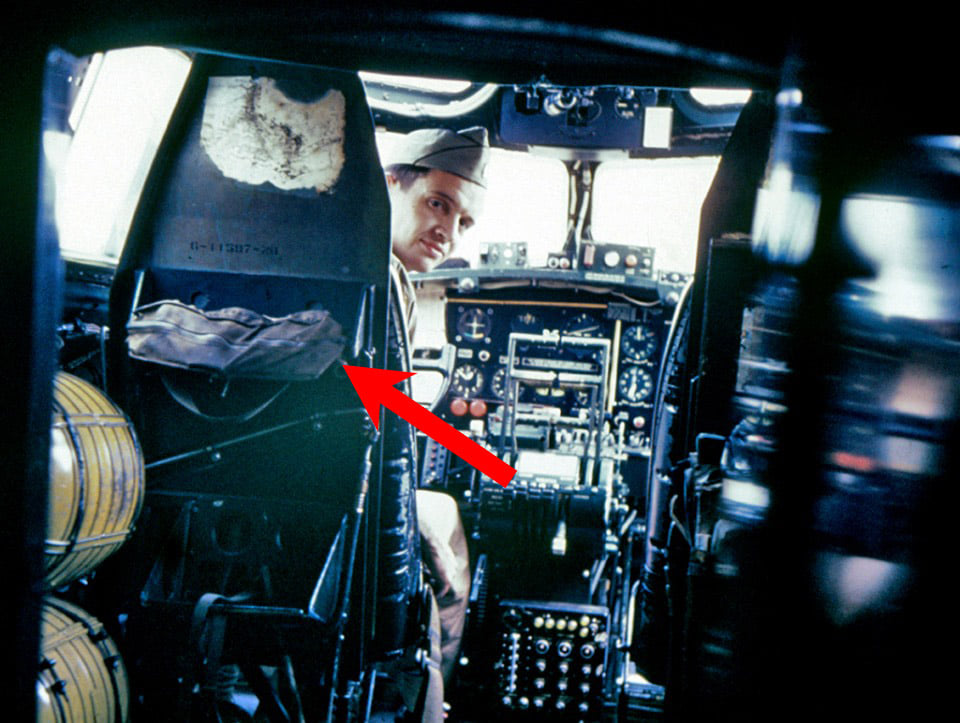
1LT Bob M. Welty of the 398BG peers over the armor plate on his seat. The A-7 flare container is highlighted.
Note the flare shelf, which we have already recreated.

The recreated flare shelf for Lucky Thirteen.
Photo taken 5 June 2019.
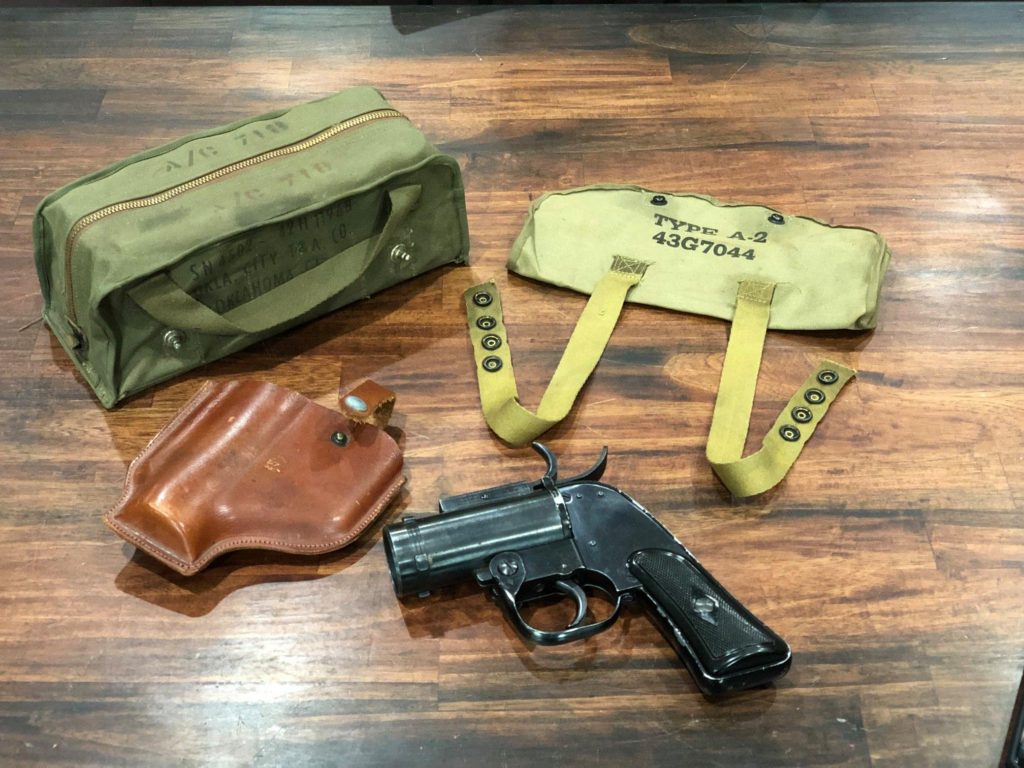
The contents of the flare gun assembly for Lucky Thirteen.
Photo taken 20 June 2021.

Wooden blanks, carefully turned to match the length and diameter of the correct flares, are packed in the A-7 flare container.
While the Army index states that the container can hold up to 18, in practice it can only hold 16. An entire row must be removed for the gun holder to attach properly, bringing the number down to 12 – which was probably an ample amount.
Photo taken 20 June 2021.

A drawing we created showing the layout of the pilot seats aboard Lucky Thirteen.
The flare gun equipment is located on a small shelf on the pilot’s seat (left). Also on this seat is the Aldis Lamp, a pair of walkaround oxygen bottles (pilot and engineer), an ashtray, and the aircraft’s familiarization manual.
The co-pilot’s seat carries the Wiring Diagram Box, a First Aid Kit, an ashtray, a walkaround oxygen bottle, the Crash Axe, and the Cup Dispenser for the aircraft’s thermoses.
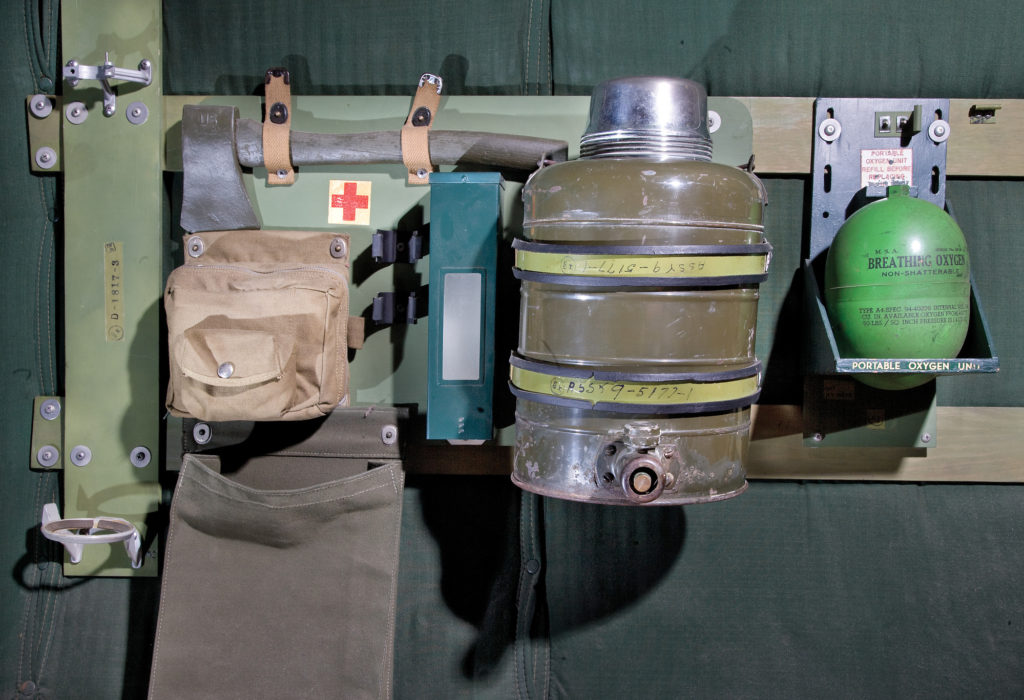
The cup dispenser is one of our most highly sought after items (aside from turret parts).
Here is a photo of an original mounted aboard the Boeing B-29 Enola Gay (44-86292, 509BG).
*We have finally located the cup dispenser as of 2023.

A B-17 of the 94BG lands at Bury St. Edmunds, firing flares to indicate wounded aboard.
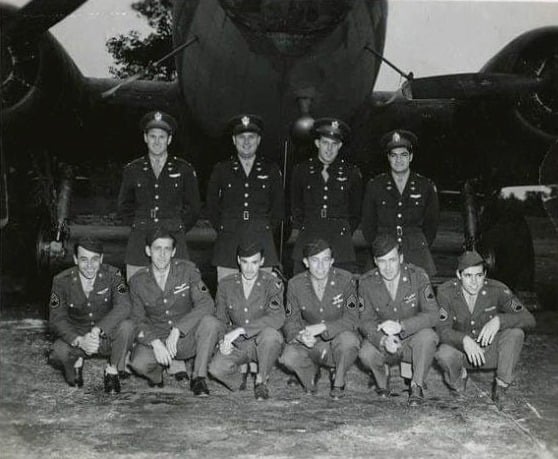
The crew of Battle Wagon (42-30026) – the crew who manned Lucky Thirteen over Schweinfurt.
Back Row (left to right):
CPT James C. McClanahan (Bombardier)
CPT Phillip M. Algar (Pilot)
1LT Richard V. Wolf (Pilot)
CPT Frank A. Celentano (Navigator)
Front Row (left to right)
SSGT John F. Schimenek (Gunner)
SSGT Casmer R. Majewski (Gunner)
SSGT Roland B. Laviolette (Engineer)
SSGT L. Corwin Miller (Gunner)
TSGT Francis Gerow (Radio Operator)
SSGT Kenneth M. McKay, Jr. (Gunner)
This crew completed their tour-of-duty on 3 March 1944, being recalled from what would have been the first US strike on Berlin.
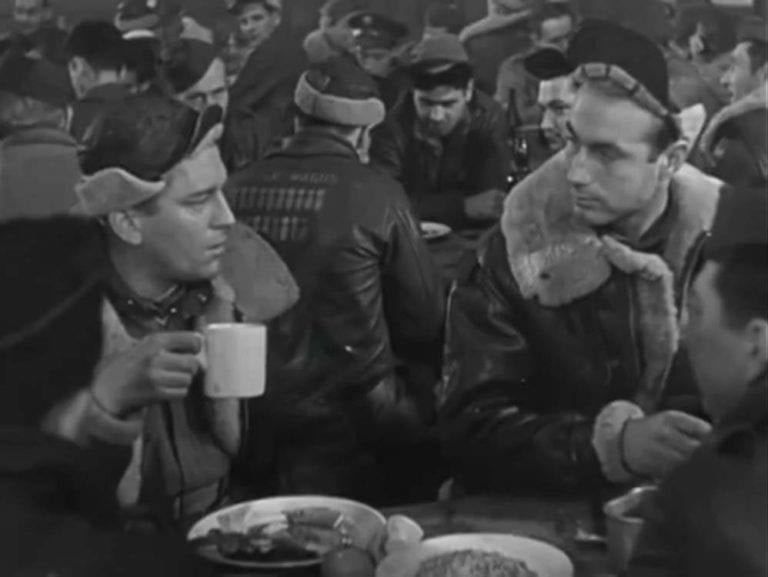
SSGT Casmer R. Majewski – the tail gunner aboard Lucky Thirteen during the Schweinfurt strike – appears in the documentary Target For Today roughly around the 29:40 minute mark. During this scene, SSGT John F. Schimenek can be seen behind Majewski eating an orange.
Majewski teases the others by referring to the “two Jerries I slapped down over Schweinfurt,” though records only confirm a single kill by Majewski that day.
Target for Today was an attempt by the Army to break down the operations of a typical US 8AF strike. The film follows the planning and execution of the 9 October 1943 bombing of Anklam, Malbork, and Gdansk, Germany and Gdynia, Poland. By that time, Lucky Thirteen had already been lost.

One of the iconic images of the air war over Europe – a unidentified B-17F is shot down during Operation JUGGLER.
The fighter that claimed it is visible nearby.
This photo was taken by SSGT John F. Schimenek from the left waist position on Lucky Thirteen.
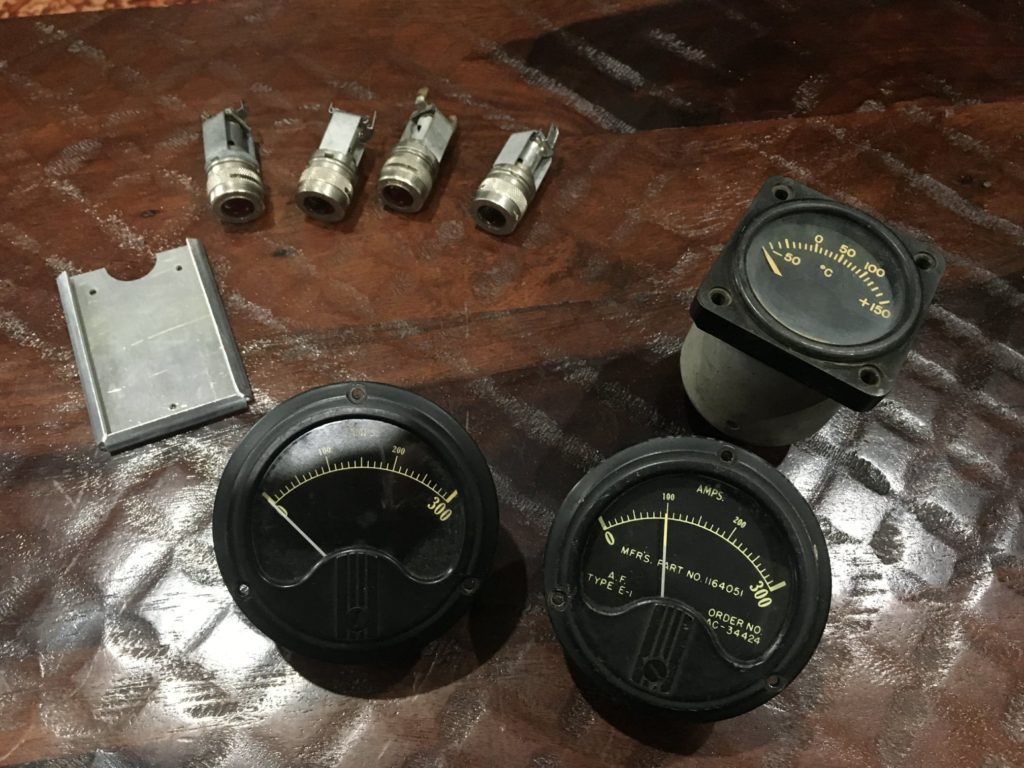
Todd Blalock’s package of parts for Lucky Thirteen.
Photo taken 3 April 2021.
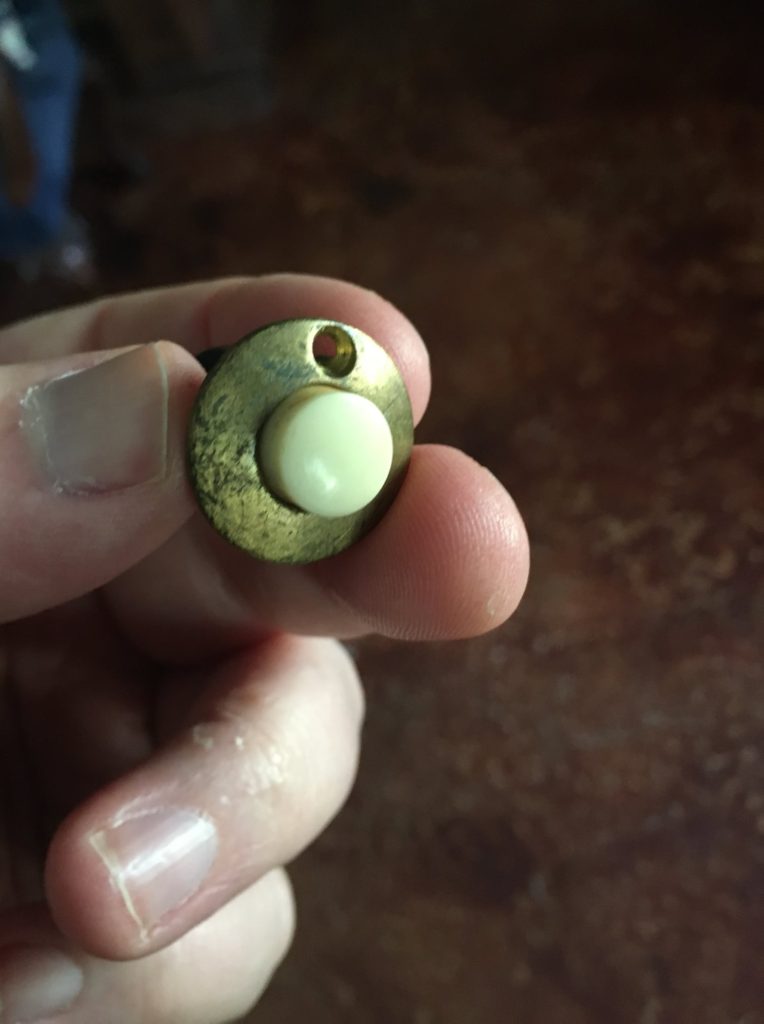
The globe test switch donated by Todd Blalock for the instrument panel. In reality, the switch was a repurposed push-to-talk switch.
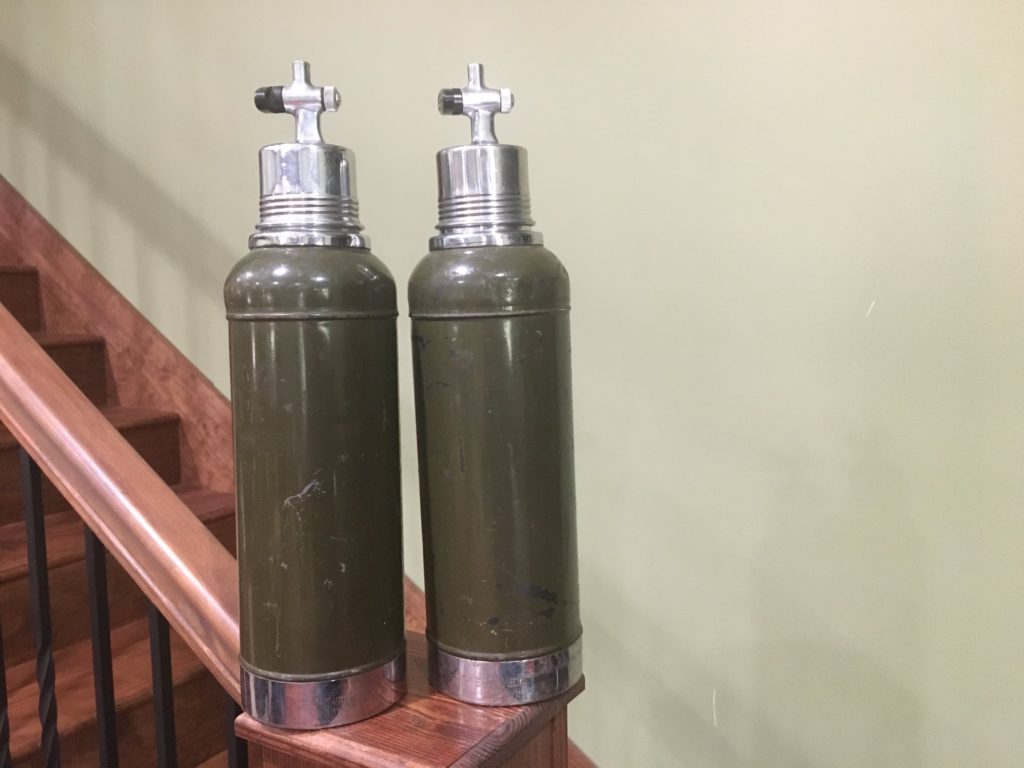
The newly-arrived thermos bottles.
The Army identification stamps are located on the rims at the bottom of each thermos.
Photo taken 13 May 2021.
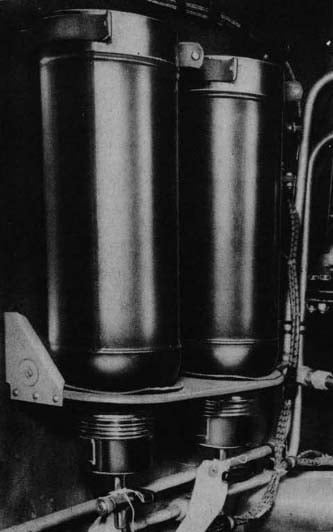
A manual illustration showing the flight thermoses mounted in place.
The thermos rack was located on the wall behind the co-pilot’s seat.
13 June 2021 was a big day. Not only was it the tenth anniversary of the fire which burned Liberty Belle, but it also saw another delivery of parts to Asheville for Lucky Thirteen. Meeting us there was John Gaertner of Blue Swallow Aircraft and Jerry Robinson, a new volunteer joining Charlie Liberto in the restoration of the aircraft’s radio equipment. John is an expert in Great War aviation and is currently casting parts for us, some of which you can follow on his Facebook page. Special thanks to these guys for visiting and helping out on the B-17F!
Amongst the parts I delivered yesterday were the ammunition boxes for the waist, nose, and cheek guns. They are now finished.
To describe in detail:
Originally, the B-17’s guns were fed through interchangeable cans. This was found to be impractical. Memphis Belle (41-24485, 91BG) for example, belt-fed her guns by mounting a pair of tail gun boxes on stilts in the waist compartment. To account for this, Boeing redesigned the B-17s waist guns to use 300 round boxes in November 1942. The boxes sat rather high, their large size giving the impression of a false bottom. Still, 300 rounds was found insufficient, and later designs – first via Cheyenne, then standardized – increased the amount of ammo these standing boxes carried. In March 1944, the standing boxes were replaced with a wall-mounted design similar in appearance to those used in the tail.
The boxes built for Lucky Thirteen follow the factory 300 round box design.
The boxes for the nose and cheek positions are a bit more mysterious.
Since these positions were installed at Cheyenne, we are limited as to resources. The blueprints for the boxes themselves are lost, but we can tell that they were similar in design to the boxes later standardized in the G series. So that is what we used.
One major difference between F and G type boxes is the way in which the ammunition feed chutes attached. G boxes generally used metal clips, through which latches on the end of the chutes could snap into place. This allowed ground crews to easily remove chutes without needing to bolt/unbolt each unit. These clips are installed in the nose/cheek gun boxes since we have no references to an earlier design. Better safe than sorry!
The metal for these boxes was fabricated by Bob Hachmann up in Iowa and he did a fantastic job. The rollers were turned for us by MoBat baseball bats of Missouri. The Douglas Fir – the correct wood for this project – was found by Berlin G. Meyers Lumber of Charleston, South Carolina.
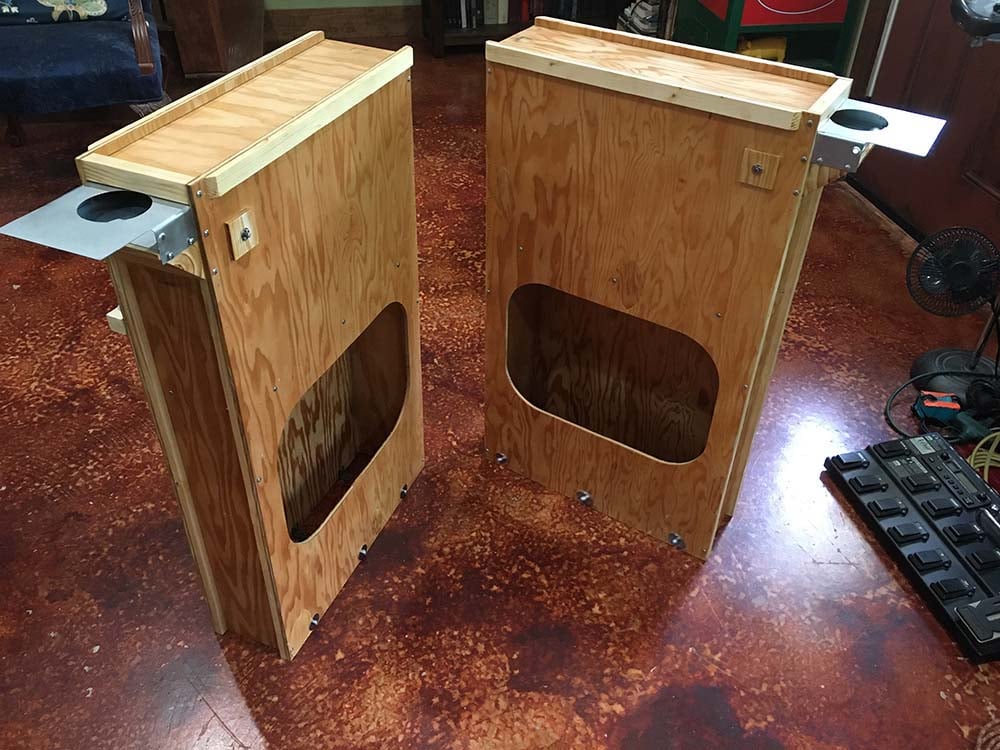
The finished waist gun ammo boxes for Lucky Thirteen sit in my living room. The right waist box is on the left, the left waist box on the right.
Photo taken 10 June 2021.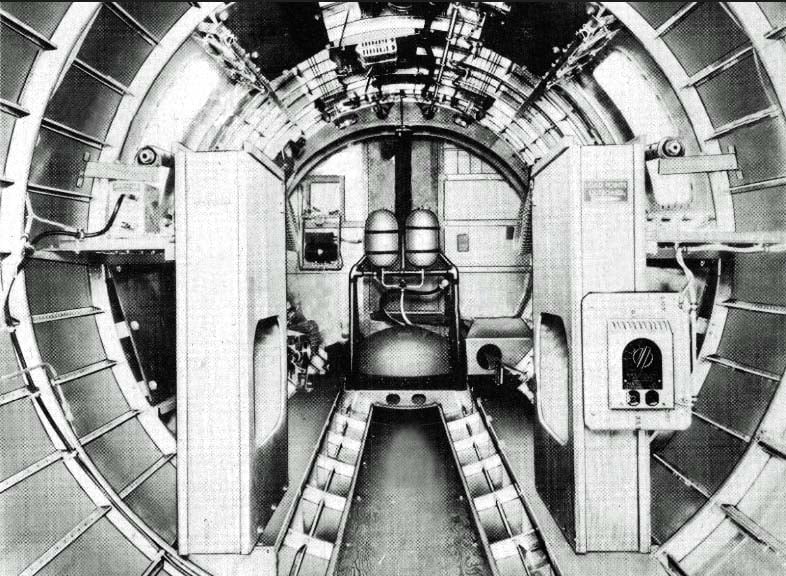
A manual illustration showing the layout of a B-17F waist position virtually identical to Lucky Thirteen.
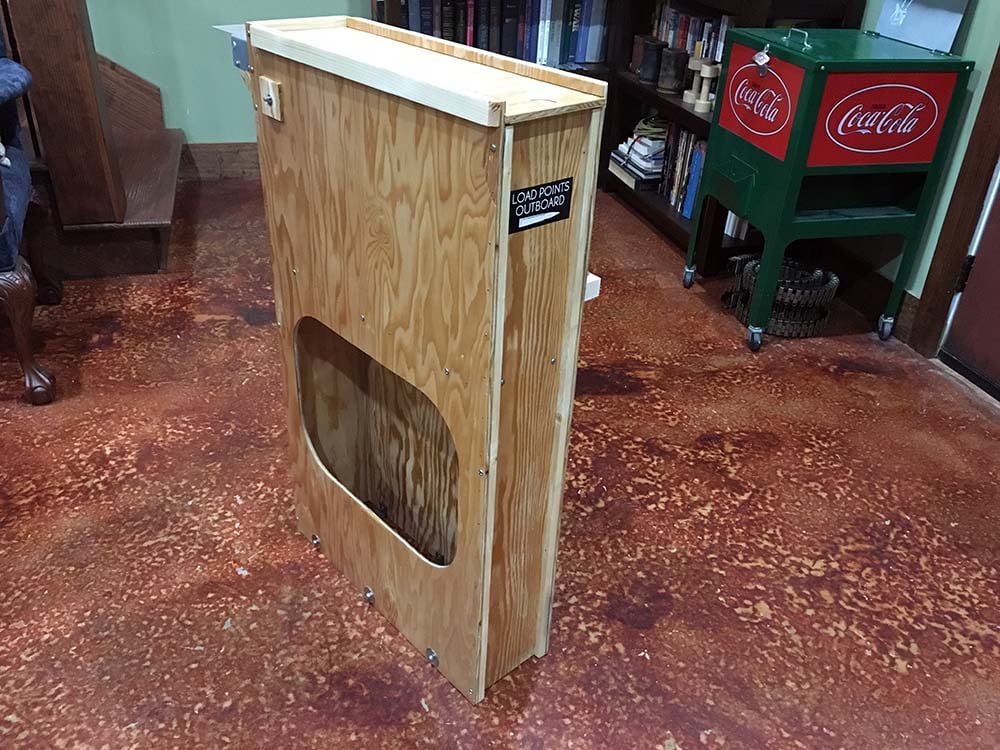
The right waist box sits in my living room. The markings were recreated by my wife Megan at Tech Design Strategies, using blueprint specifications.
Nearby you can see a single ammo feed chute. Despite appeals for ammo chute donations, none came forth. As such, we still only have the one chute (a right-hand feed).
Photo taken 25 May 2021.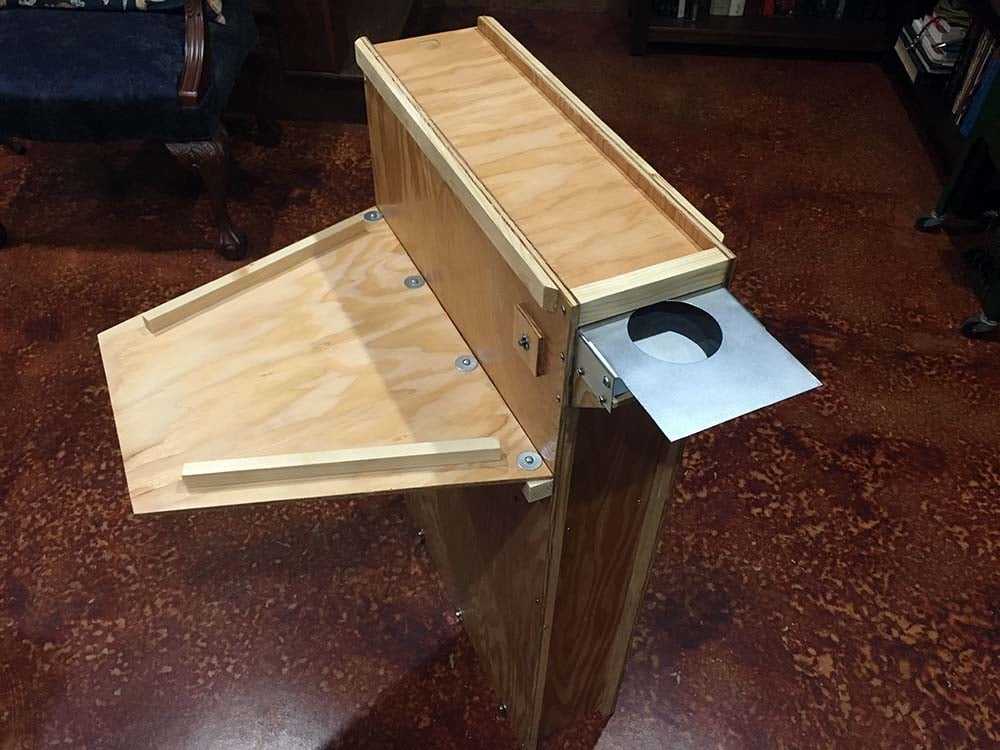
The wall bracket is temporarily fitted to the right waist box. Intended to prevent the top heavy box from swaying, the bracket of the left waist box also holds the radio beacon receiver.
The waist boxes are unique in having lids which slide in and out of place. The lid is visible here, along with its thumb groove on the end.
Photo taken 24 May 2021.
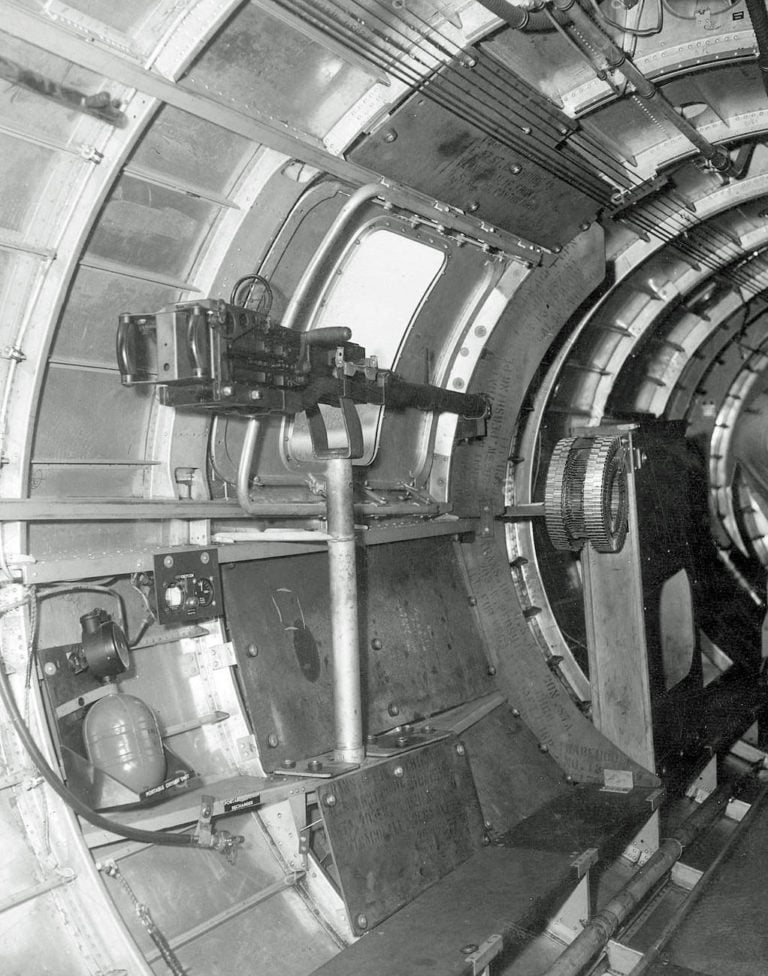
The right waist gun position on a B-17F similar to Lucky Thirteen.
Judging by the angled armor plate on the rear side of the window, this F-model is slightly older.
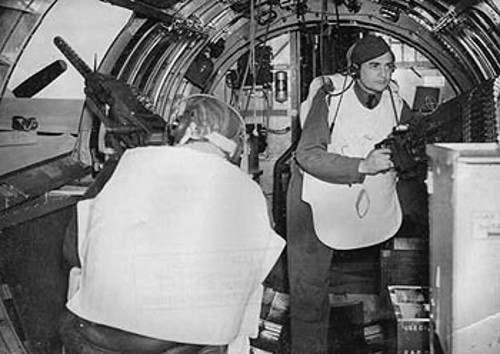
Publicity photos highlighting the introduction of steel flak jackets in early 1943.
The sliding lid on top of the waist boxes is visible here.
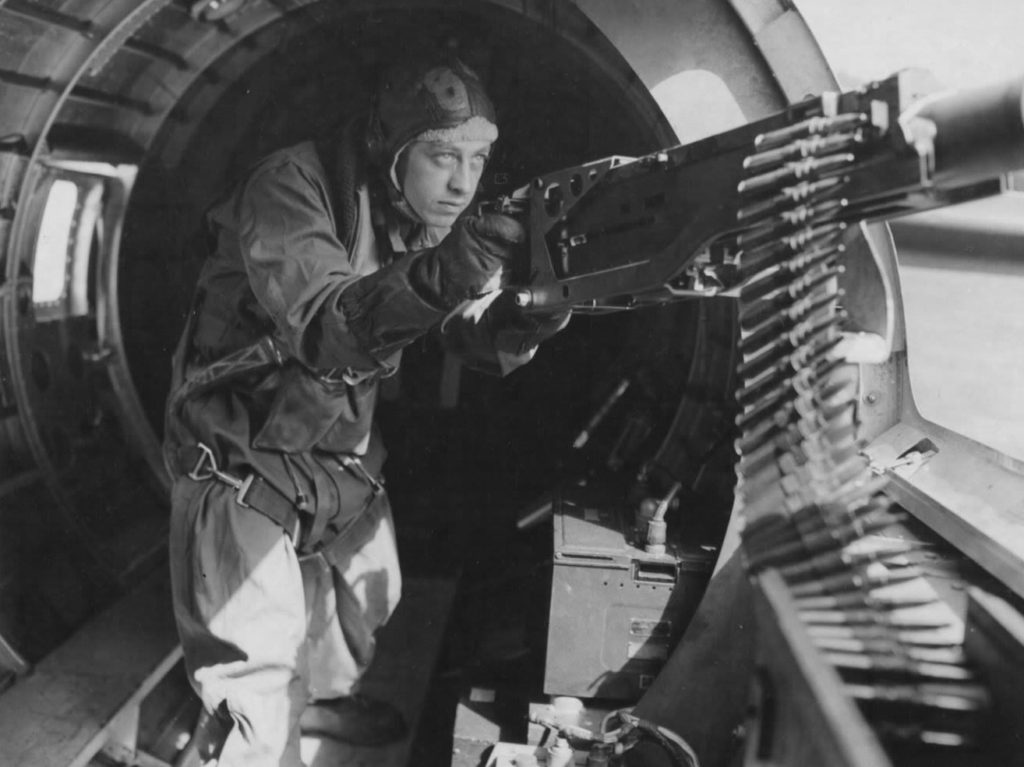
Publicity photo of SSGT M. H. “Snuffy” Smith of the 306BG. Smith won the Congressional Medal of Honor for his acts on 1 May 1943, climbing out of his ball turret to fight a fire and tend to wounded after three of the crew had already bailed out.
This photo shows an early example of this type of waist ammo box. The box is mounted backward from normal and its lid and chute attachment assembly have been removed. Note the large radio on the opposite side of the window – this is the BC-602 control box for the SCR-522 VHF radio system. 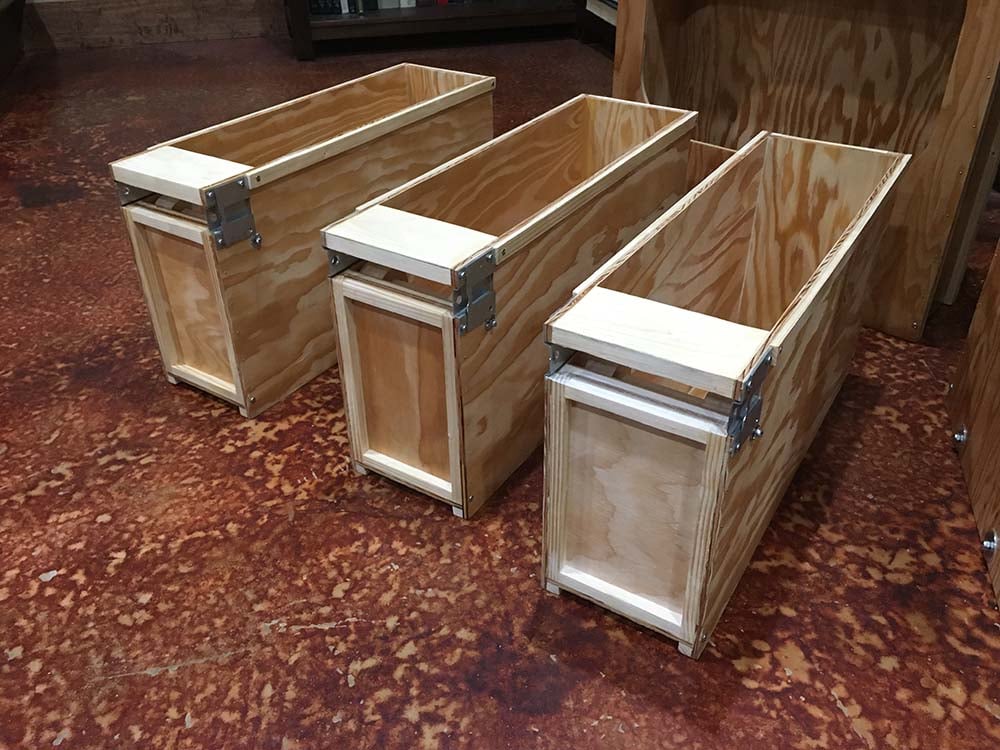
The three nose/cheek ammo boxes for Lucky Thirteen.
Just like the waist boxes, each of these held 300 rounds.
Photo taken 12 June 2021.
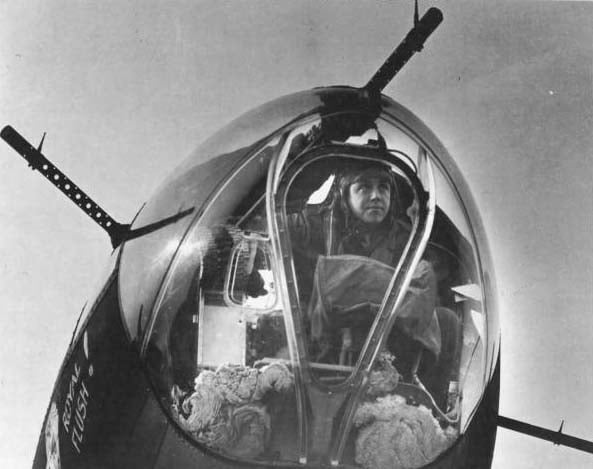
1LT Edwin R. Bush peeks out the nose of Royal Flush (42-5132, 91BG). Royal Flush was lost on 22 June 1943 over the North Sea. Bush survived but was killed in an accident over Offutt AFB after the war. Note the insulation that has been stuffed in the bottom of the nose, presumably to cut down on vibration or to keep spent brass from collecting. This practice can be seen in virtually all F-models with nose gun modifications.
The box which feeds the nose gun is visible on the left.
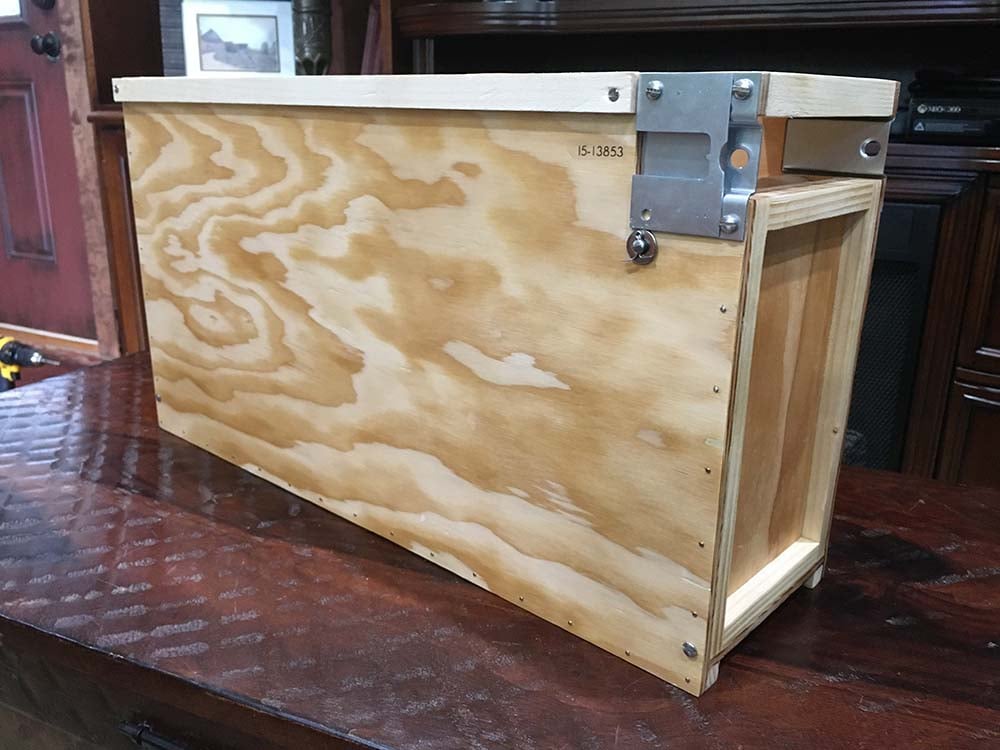
A closeup of one of the nose/cheek boxes.
Like all of the B-17’s boxes, the plywood is made of Douglas Fir and the stiffeners from Spruce. Since Fir is not a local wood, it has to be specially purchased.
Wartime Boeing practice was strictly replicated on these boxes. Not only were the parts glued together, but brass brad nails were spaced according to wood thickness. This particular box used a 1-1/2 inch spacing. The waist boxes had a wider spacing of 2-1/2 inches.
Photo taken 10 June 2021.
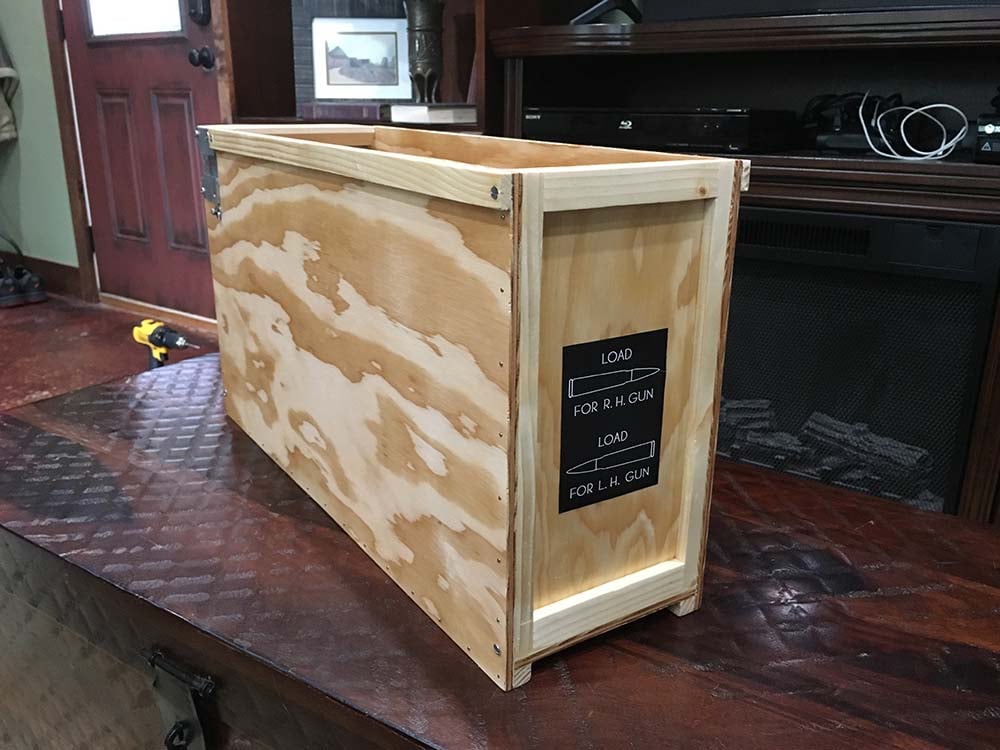
A closeup of one of the nose/cheek boxes.
The feed direction refers to which side of the gun the ammunition is to attach. The ammo has to be loaded facing accordingly.
Photo taken 10 June 2021.
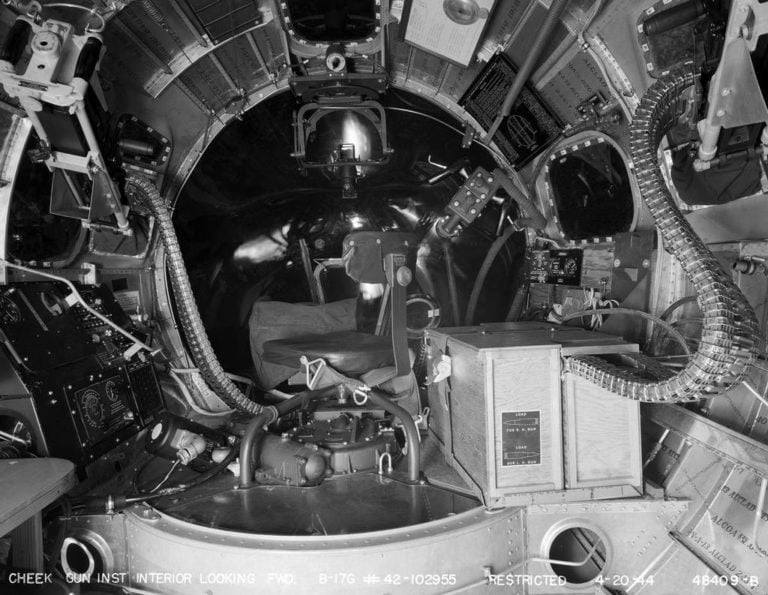
The cheek boxes of a B-17G Chatterbox II (42-102955, 351BG).
Note the decal highlighting feed direction, which has been applied out of center.
Photo taken 20 April 1944.
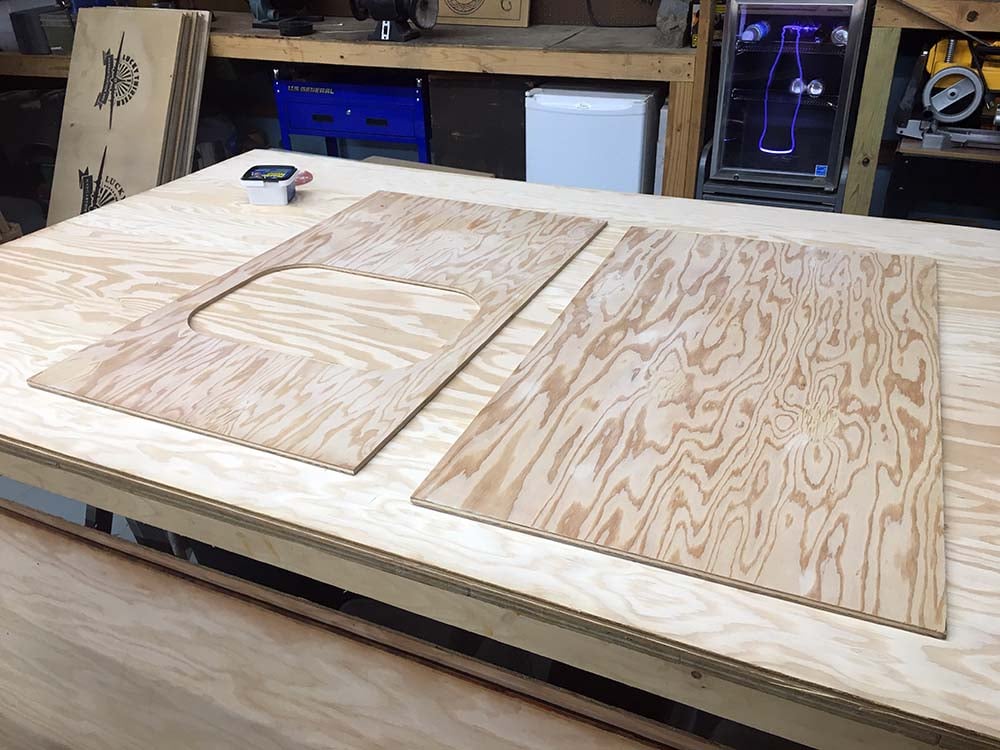
Two panels cut out: the inner panel of the right waist and the outer panel of the left. On the other side of the panels are grooves cut for the lid and false bottom.
Photo taken 24 April 2021.
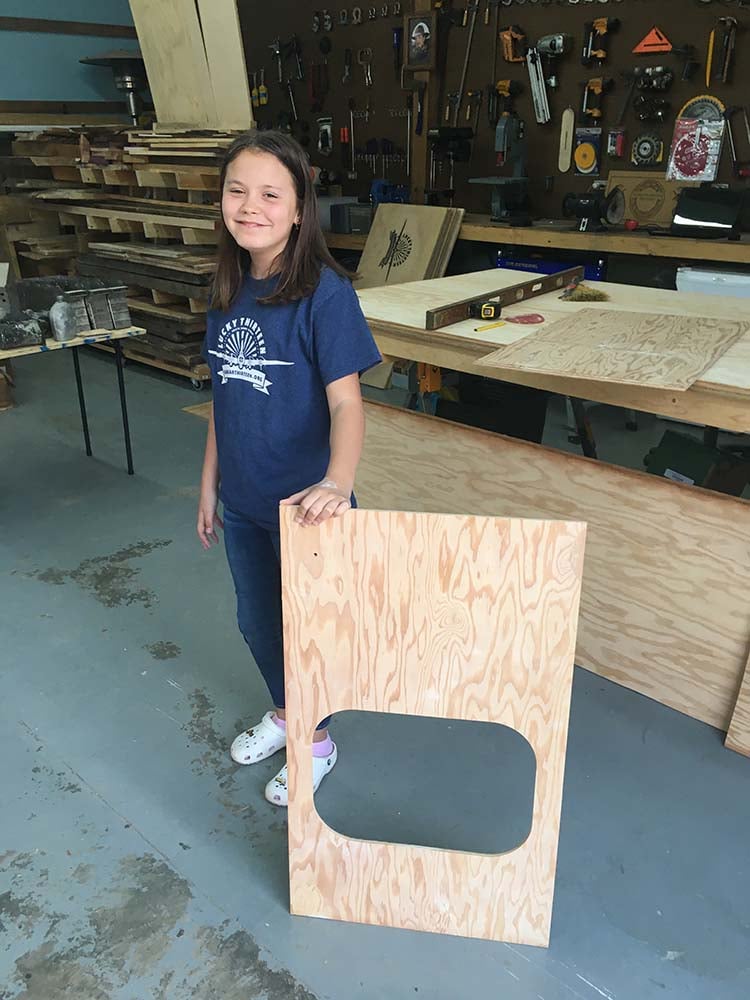
My cousin Brook posing with the right waist inner panel. As you can tell, these boxes are rather tall.
Photo taken 23 April 2021.
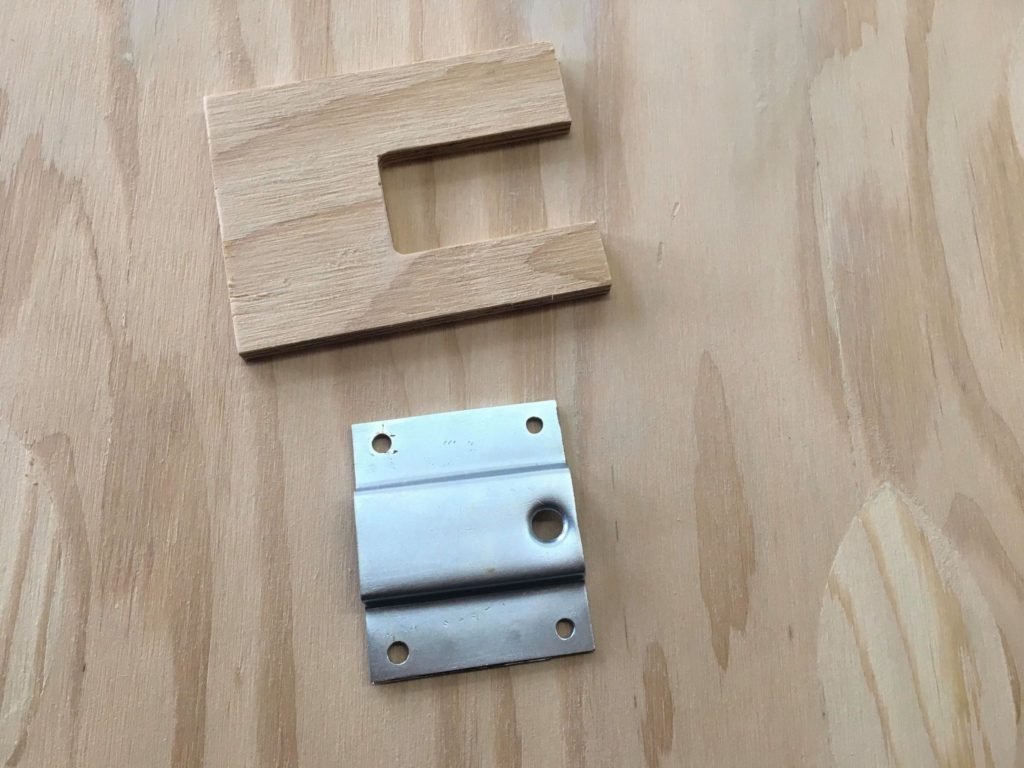
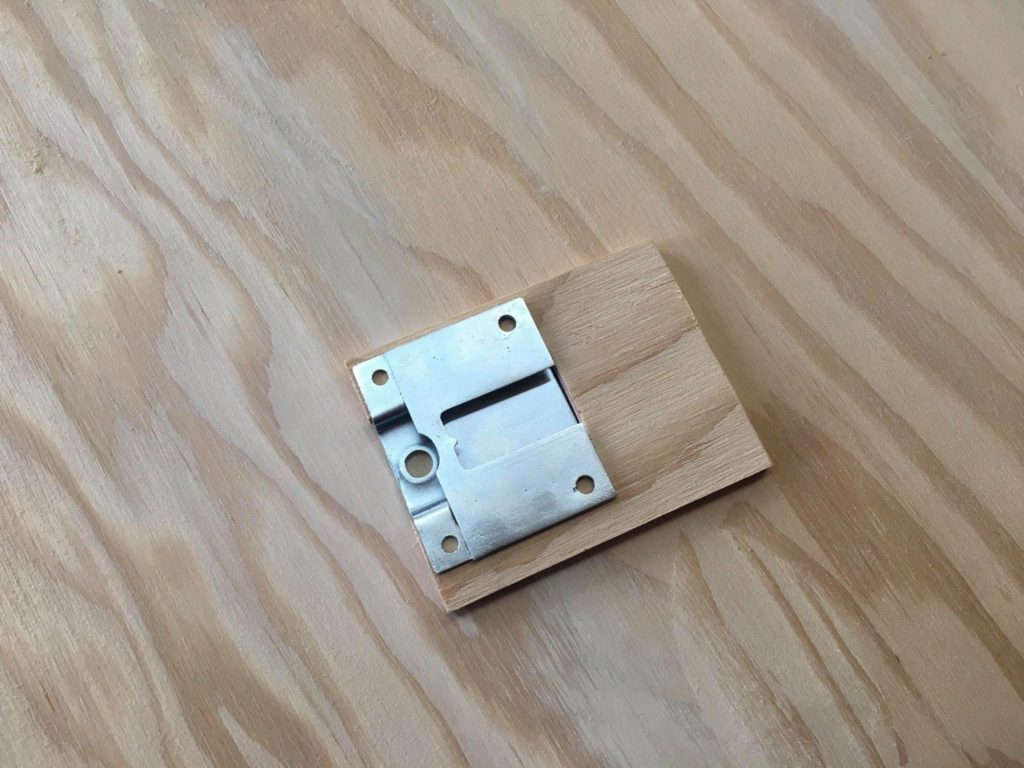
Test fitting the attachment clips for the nose/cheek boxes using a scrap piece of wood.
Photo taken 26 April 2021.

Construction photo showing Spruce stiffeners being glued and clamped to Douglas Fir plywood. Volunteers who use the most clamps are awarded the honorary Jed Clamp-It Award.
That big rock is actually an old grave stone that we keep in the wood shop. Will have to share the story behind that stone someday…
Photo taken 30 April 2021.

The steel pieces made by Bob Hachmann are cadmium plated according to wartime specs.
Before building the radio compartment’s ammo box, its pieces, which are aluminum, will have to be anodized.
Photo taken 18 March 2021.
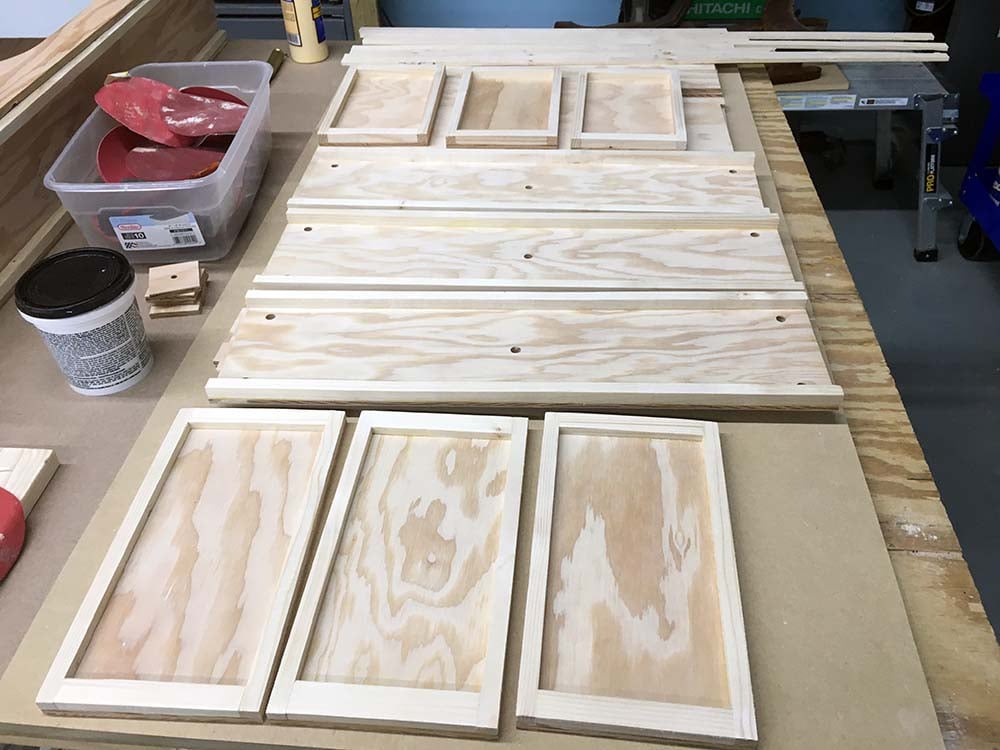
Fronts, backs, bottoms, and trim pieces for the nose/cheek boxes are pre-cut, sub-assembled, and checked for flaws.
Photo taken 11 May 2021.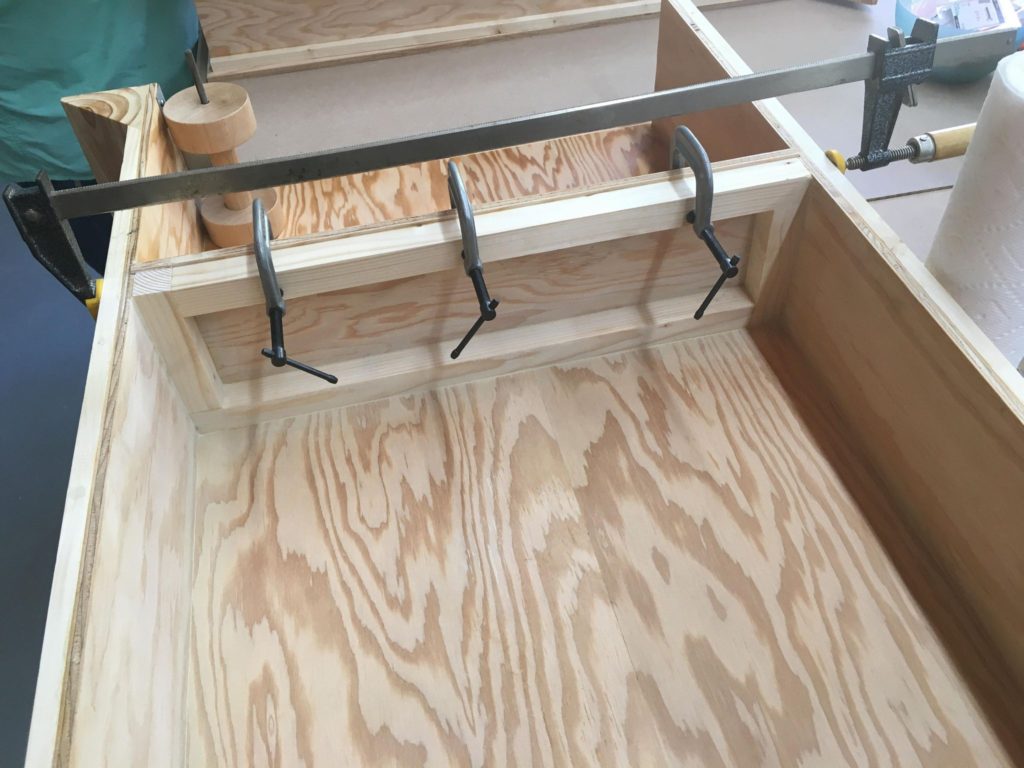
The false bottom of the right waist box is installed and clamped.
Photo taken 15 May 2021.

The interior of the right waist box prior to being closed up. The interior is lacquered prior to assembly. Though it may be overkill, I put as much attention into these boxes as I do into building cabinets.
The size of the box’s false bottom is apparent here, as is the roller assembly (which is hanging loose for the photo).
Photo taken 16 May 2021.
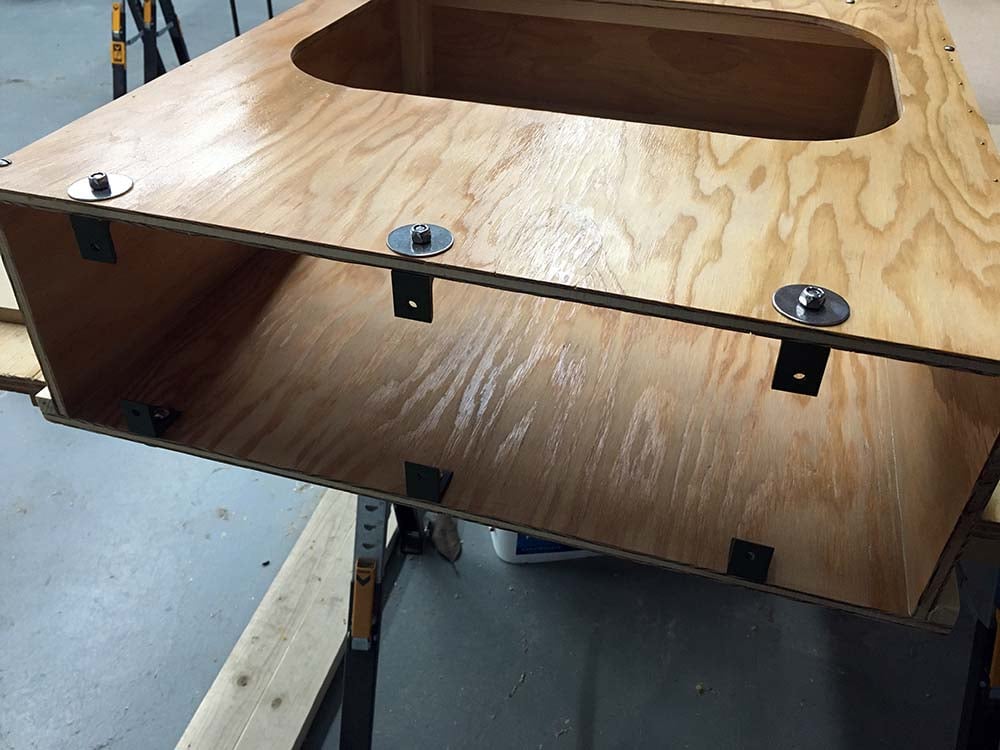
The feet of the waist boxes are dipped in zinc chromate as per Boeing specifications and attached. These will later be bolted to the floor of the waist compartment.
The shine of the lacquer is also visible. We use a special lacquer which should not discolor with age.

The left waist box standing in my woodshop, prior to having its feet installed.
Bob’s work on the metal feed mechanism is visible here. The ammunition chute is attached to a pair of extrusions. We are the first B-17 project to accurately replicate this feed assembly.
Photo taken 9 June 2021.
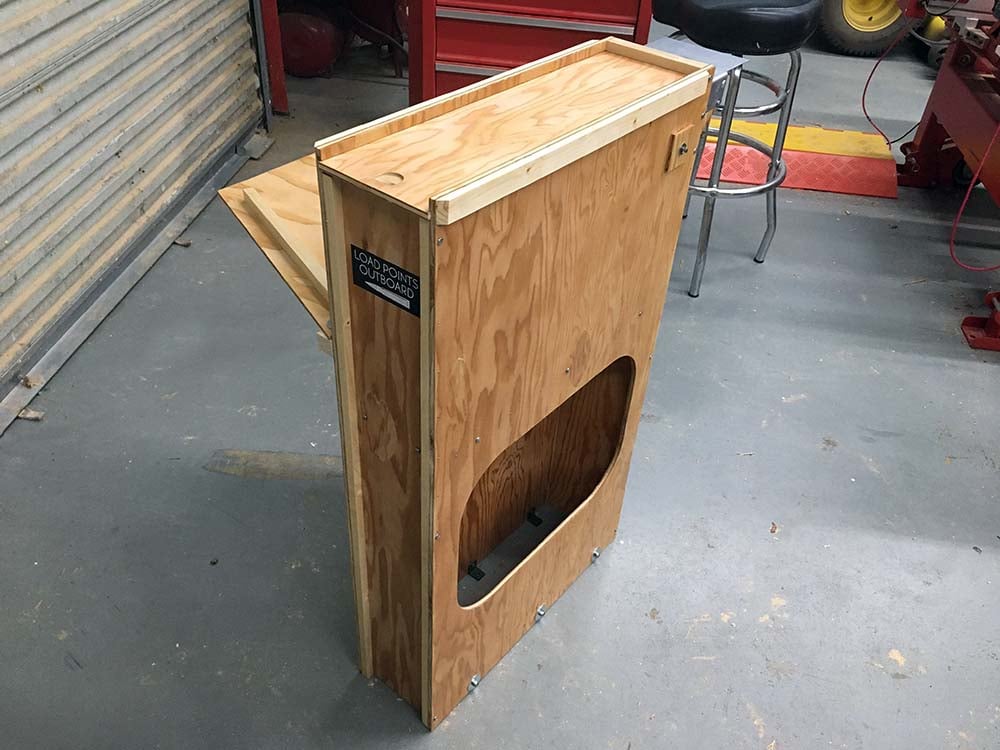
The finished left waist box, with its wall bracket attached and decal applied.
The lid assembly with its finger tab are very noticeable here.
Photo taken 12 June 2021.
Some pics from Ray of his work on Station 5 for Lucky Thirteen. Apparently Don Price called, chiding him to share more updates on our bird. Keep it up, Don! Ha!
The C channel comes from Piccadilly Princess (44-83542). The green portion is also original – in fact, it still has the clips on it for the bomb hoist rack (which we still need). The silver panel is new. It won’t be long before it is ready to have the period-correct ALCLAD markings applied.
The door I made some time back is now mounted for test fitting. All that remains is for it to be lacquered and have its charts applied. The charts that go on this door consist of hand-operated fuel pump instructions and a loading chart for the aircraft’s bomb bay. The hinges and door latch plates will have to be anodized and additional handles will have to be cast, so if anyone can help with these services…
It is always exciting to see pieces come together like this. Next up will be to redo the green skin on the opposite side.
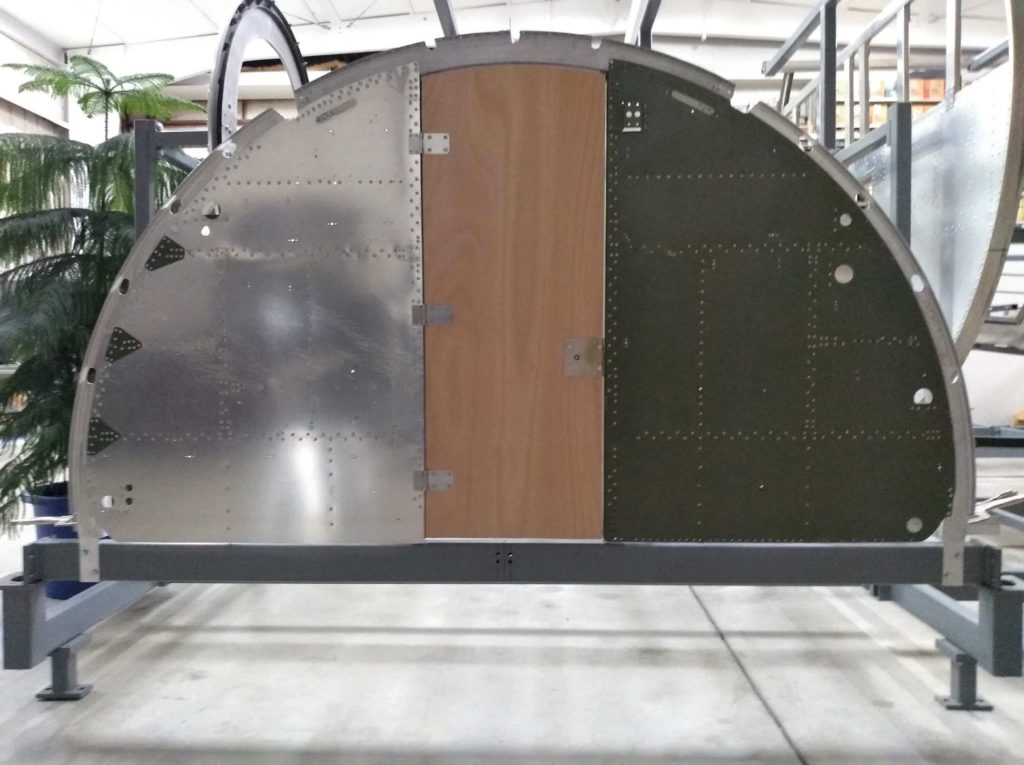
The door to Station 5 is test fitted into place. Once the door is lacquered and its hardware anodized, it can be permanently installed.
The hinges were made for us by Midlake Products & Manufacturing of Louisville, Ohio using the original blueprints.
Photo taken 4 June 2021.
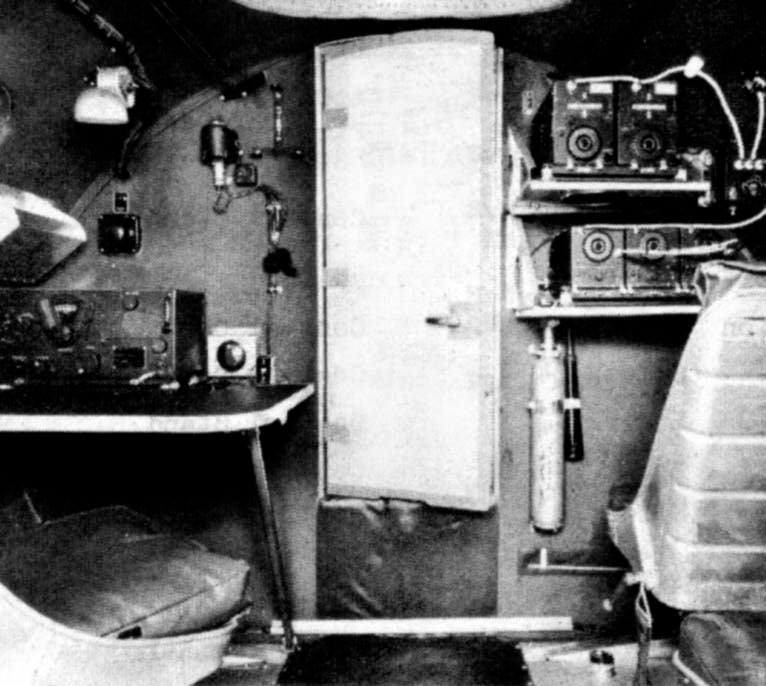
A manual photo of Station 5. The lower half of Station 5 actually consists of the carry-thrus for the wing spars and angles up slightly on this side (not visible for the chairs).
Some things of note in this photo: Notice the T-bracket beside the door, which holds the IFF control boxes – removed here as they were top secret. The extra chairs in this room are also not characteristic of combat aircraft.
Also note the kickpad below the door, a characteristic of insulated B-17 compartments.
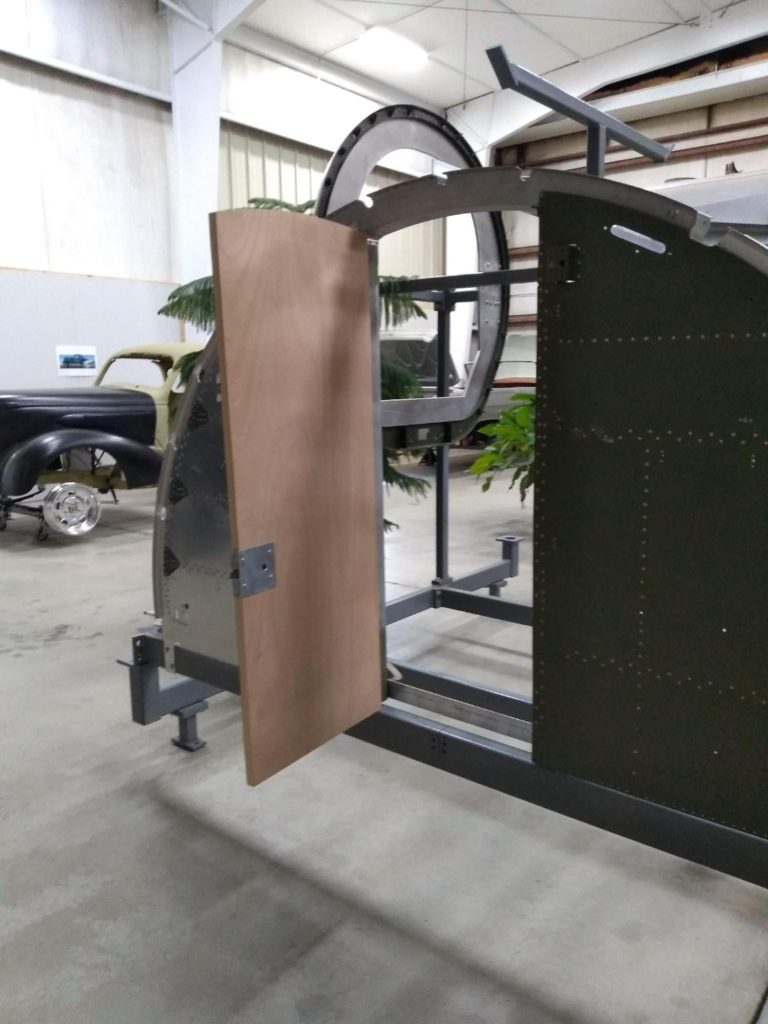
The door to Station 5 is test fitted into place. Ray was extremely pleased about the fit of the door. So am I – it’s a relief considering I was only working from blueprints at the time!
Photo taken 4 June 2021.
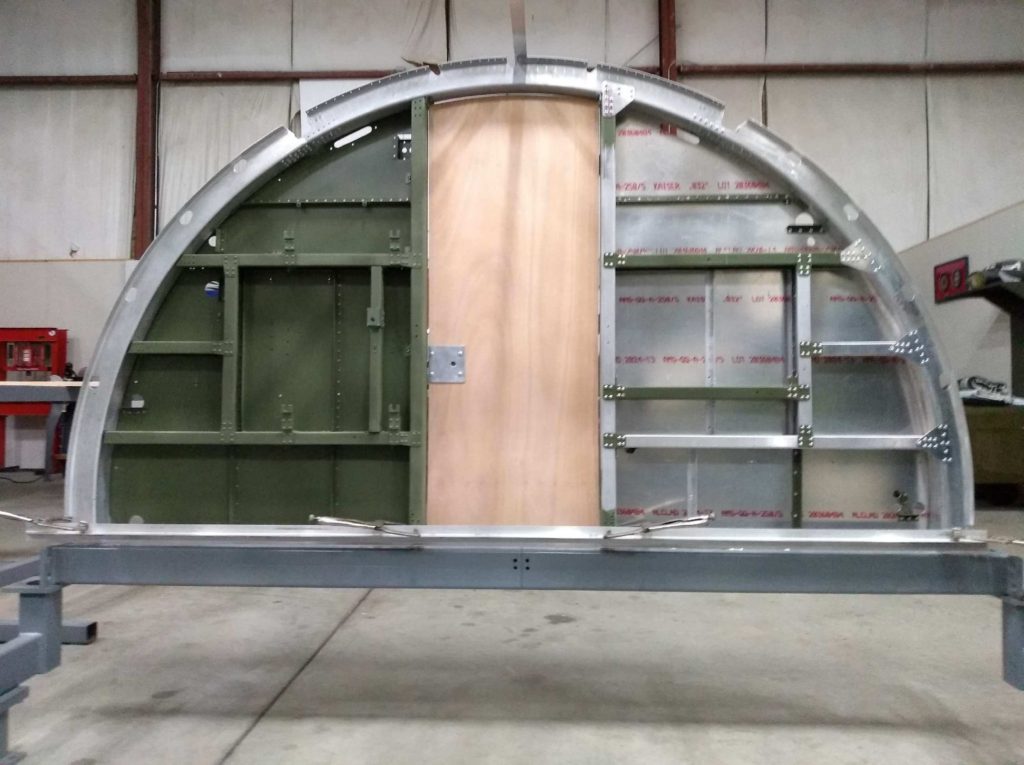
The bomb bay side of Station 5, with the door now fitted into place.
Photo taken 4 June 2021.
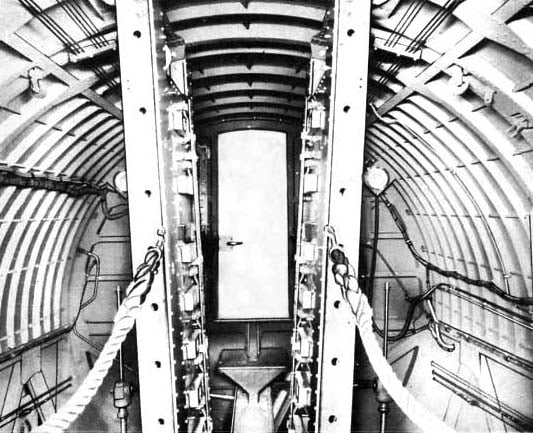
A manual illustration of the bomb bay side of Station 5.
Though the bombracks obscure them in this photo, there are some points of interest on either side of the door. The right side mounts an oxygen station, a walkaround oxygen bottle, the emergency fuel pump, and the urine relief tube. The left side mounts the rack for the bomb hoists.
The Station 5 we are rebuilding still has the connector points which hold the bomb hoist rack assembly.
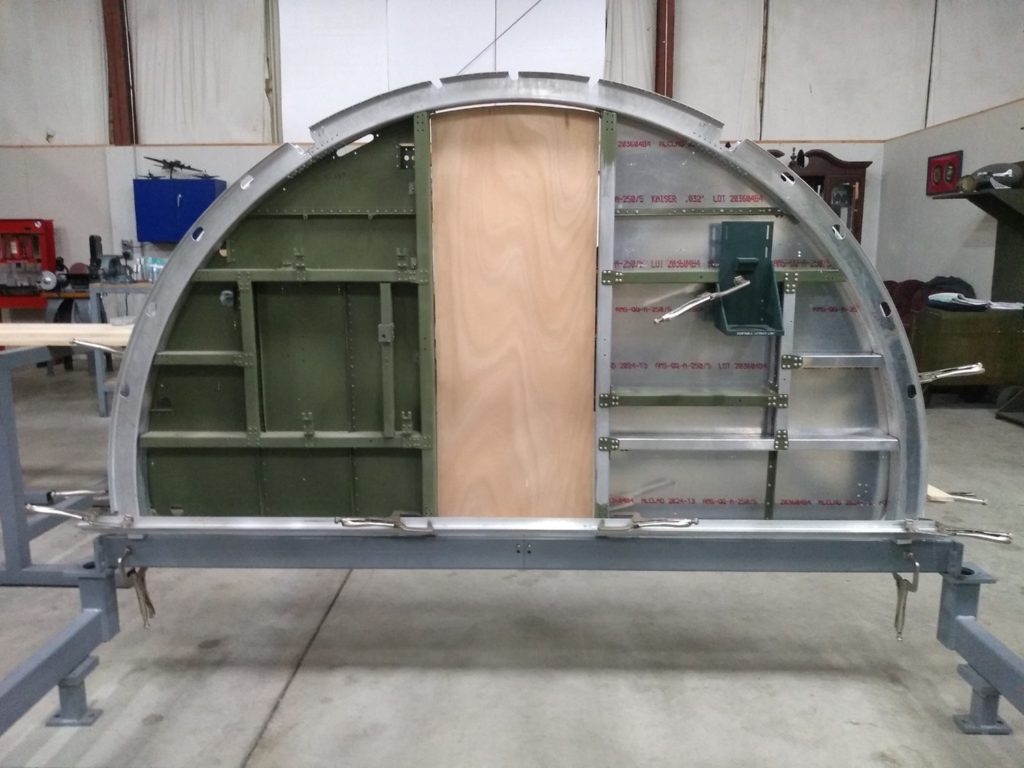
A portable oxygen bottle rack is clamped into its future position in Lucky Thirteen’s bomb bay.
Photo taken 11 May 2021.
Thought I’d share some recent pictures of Ray’s work on the aft fuselage of Liberty Belle (44-85734) for the Liberty Foundation. He’s been working to reskin the area around the tail wheel.
Photos taken 11 June 2021.
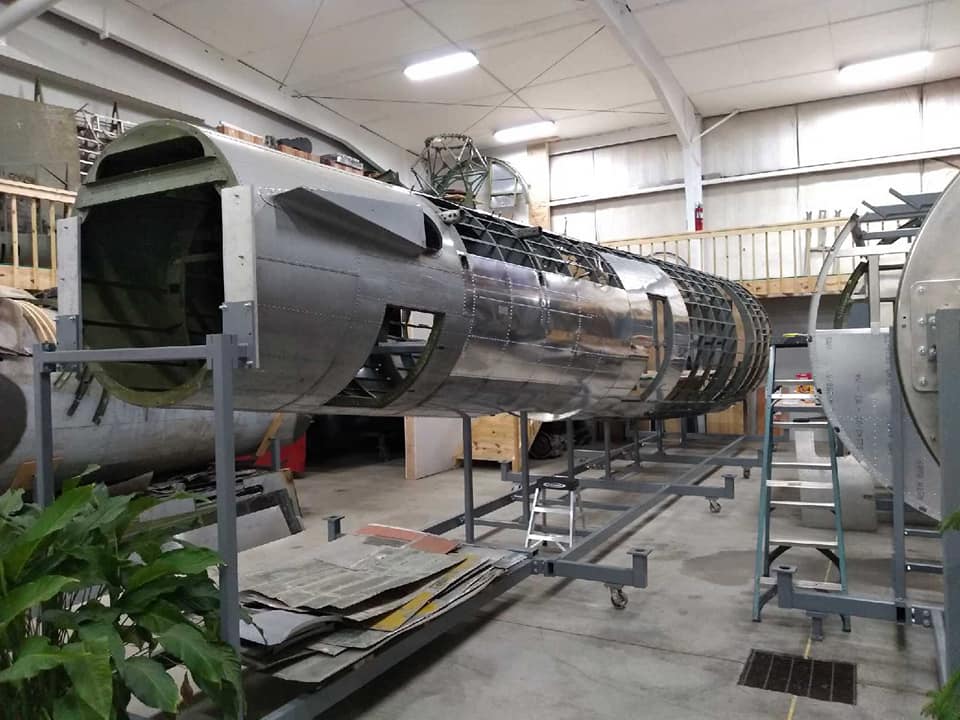

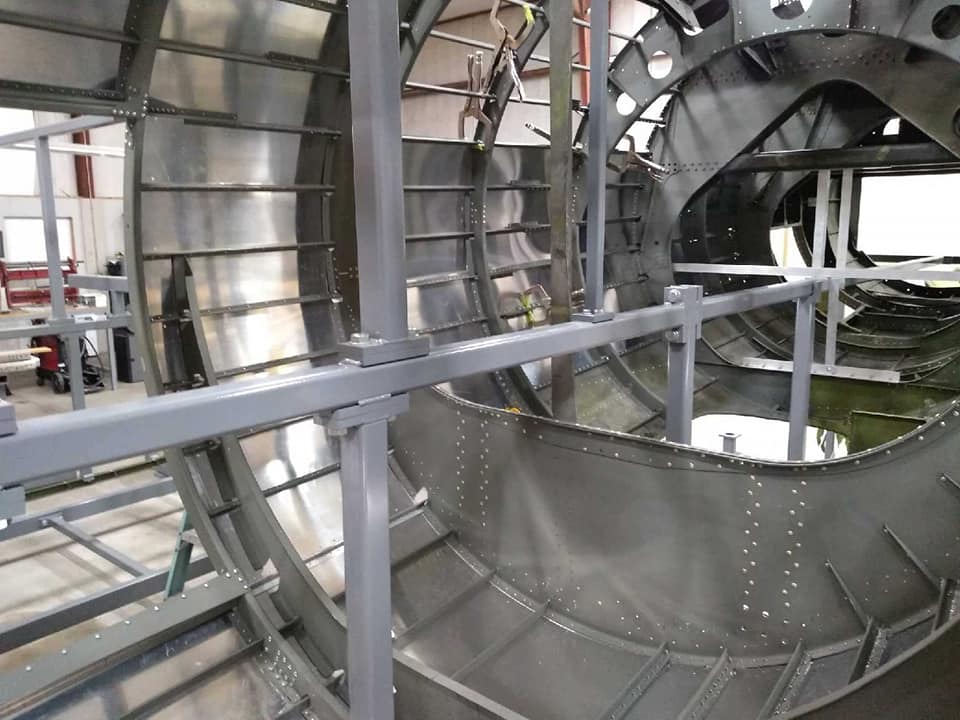
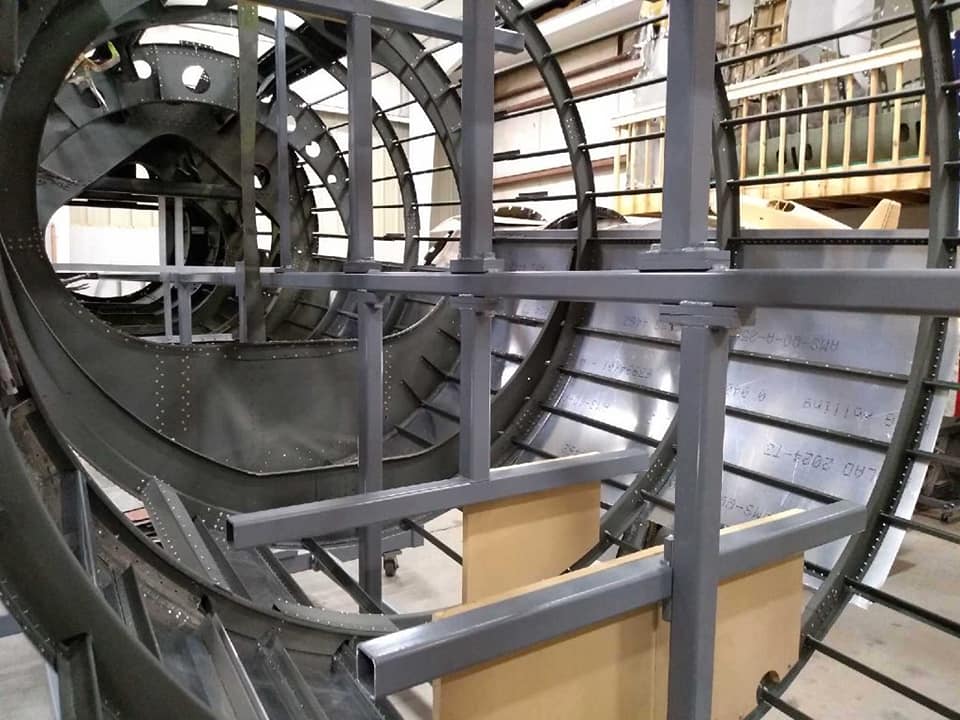
A couple recent acquisitions:
The first is a NOS windshield wiper assembly for the B-17’s nose cone. A product of Marquette Metals of Cleveland, Ohio, in conjunction with Aerotorque and the Anderson Co., this wiper was mounted on the glass plane located directly underneath the Norden bombsight. This is an incredibly rare piece as the blueprints only list a bombardier’s wiper for F-series B-17s.
Next, is a pair of pieces that Ray was able to acquire: a Type G-10 Cherry Rivet Hand Gun and a No. 416 Parker Hand Beading Tool Set. Both of these units are still in their original cases and are in fantastic shape. There are few things as cool as rebuilding a Second World War aircraft using Second World War tools!

The newly-arrived bombardier’s windshield wiper assembly, with a baseball for scale. The rubber is still pliable!
Photo taken 26 April 2021.
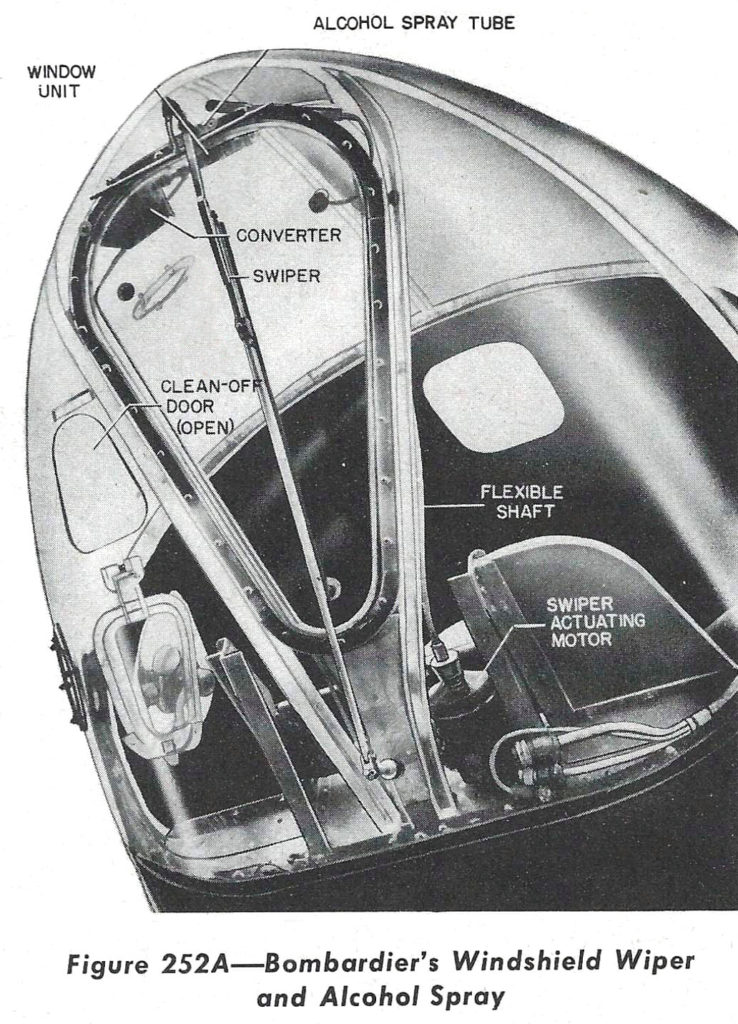
A manual illustration showing the installation of the bombardier’s windshield wiper.
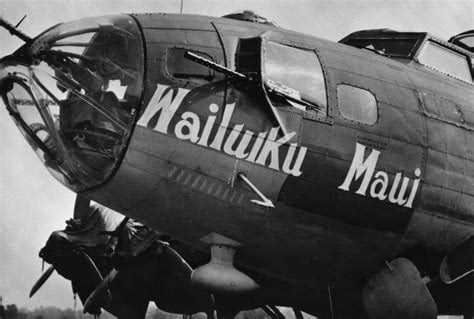
Wailuku Maui (42-3295, 388BG), a late Douglas-F just like Lucky Thirteen. Note the windshield wiper assembly under the nose.
Wailuku Maui was lost over the Pas De Calais on 24 December 1943 during a NO BALL strike against V-1 launch sites.
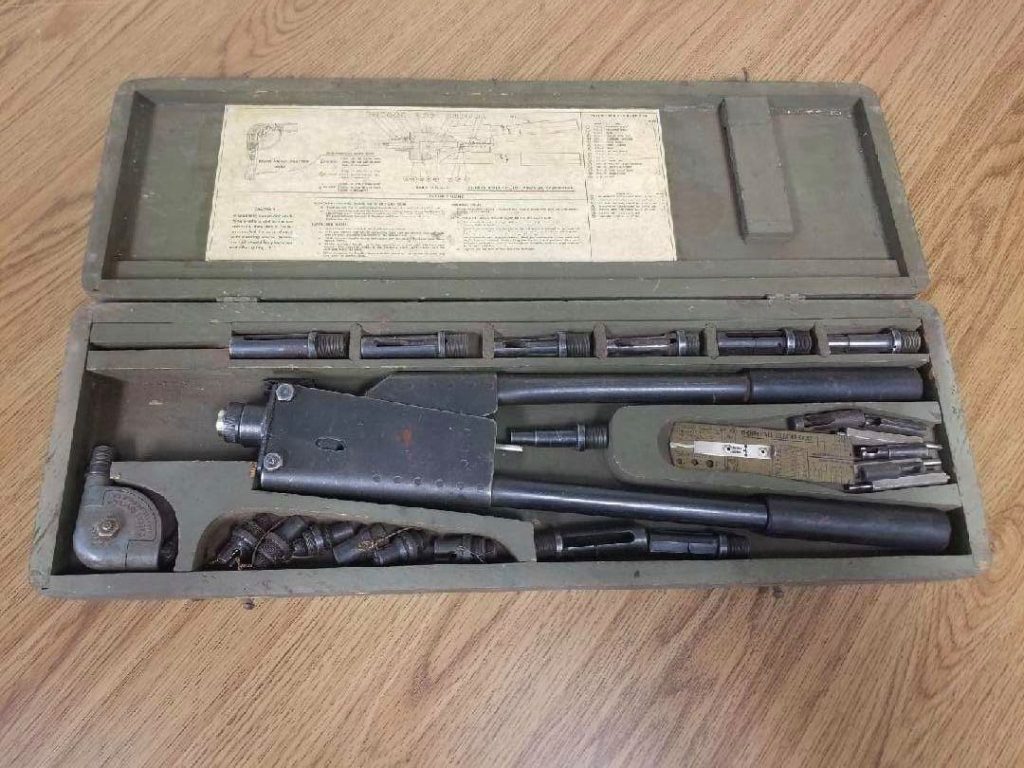
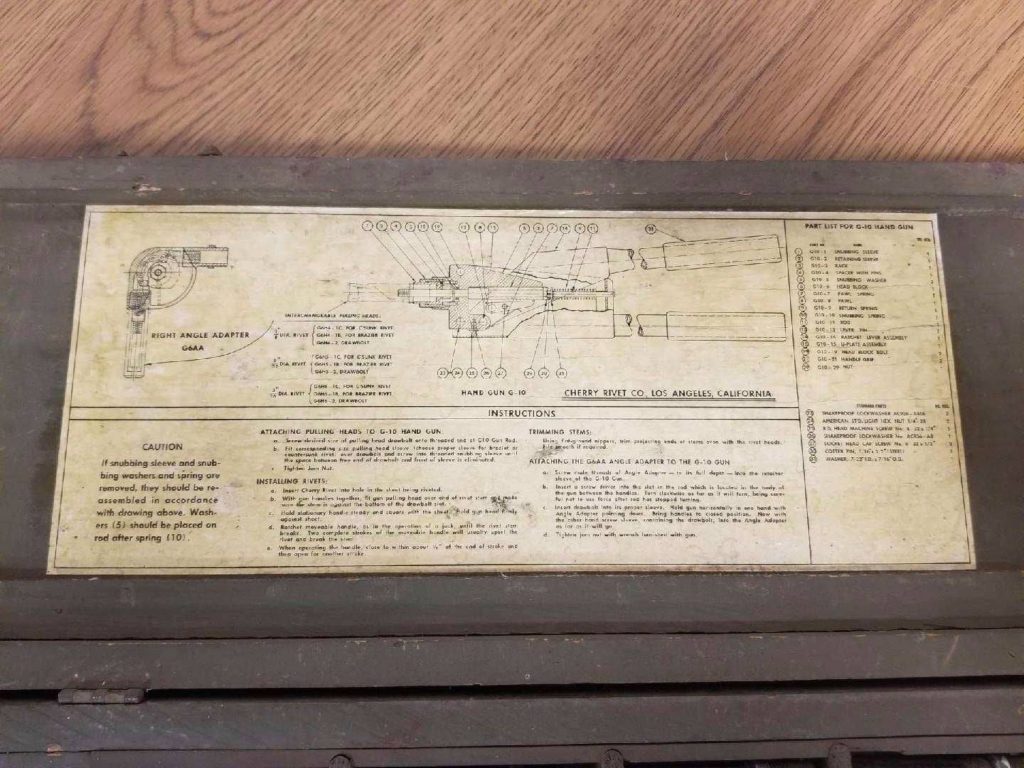
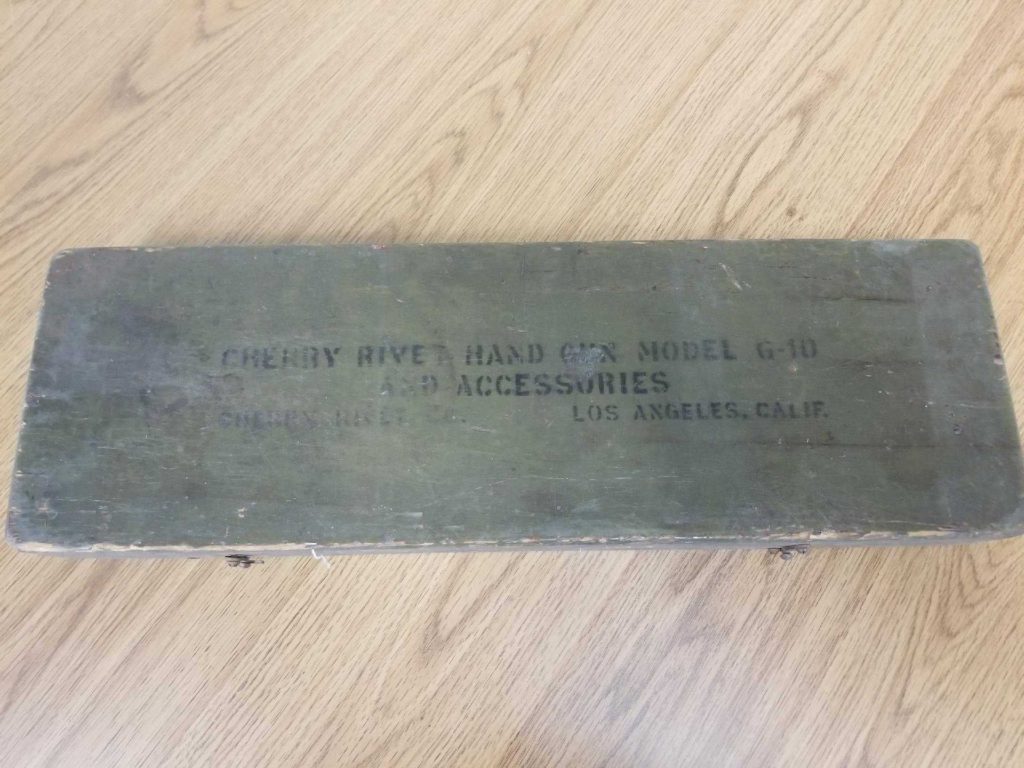
The Type G-10 Cherry Rivet Hand Gun.
Photos taken 29 May 2021.
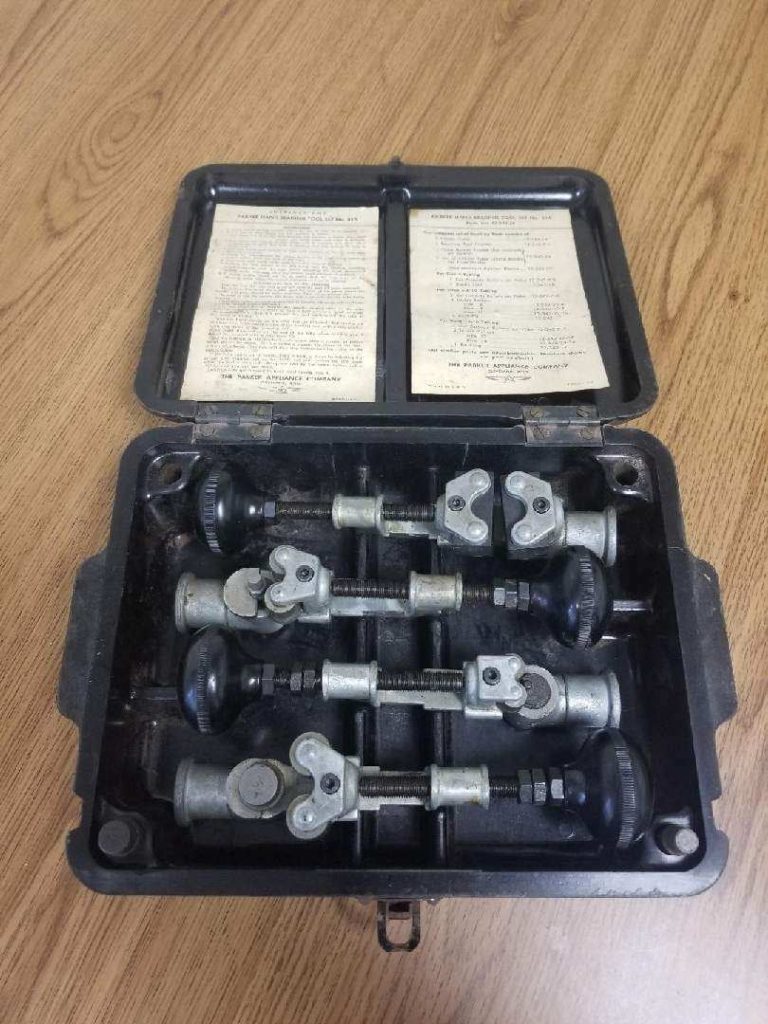
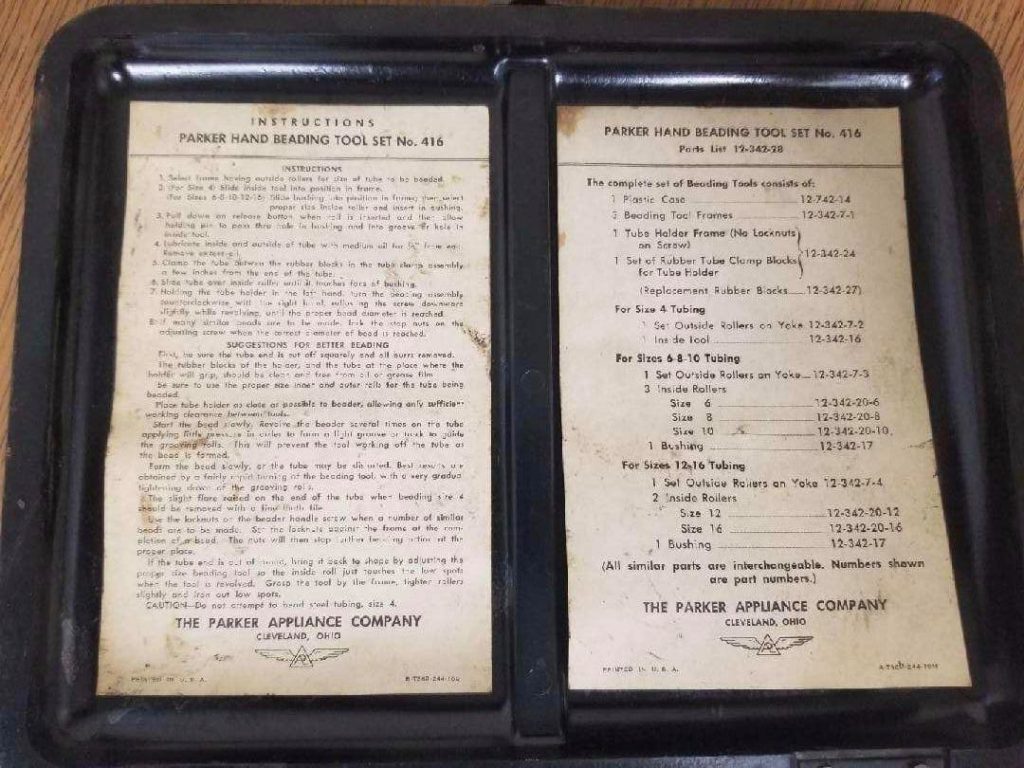
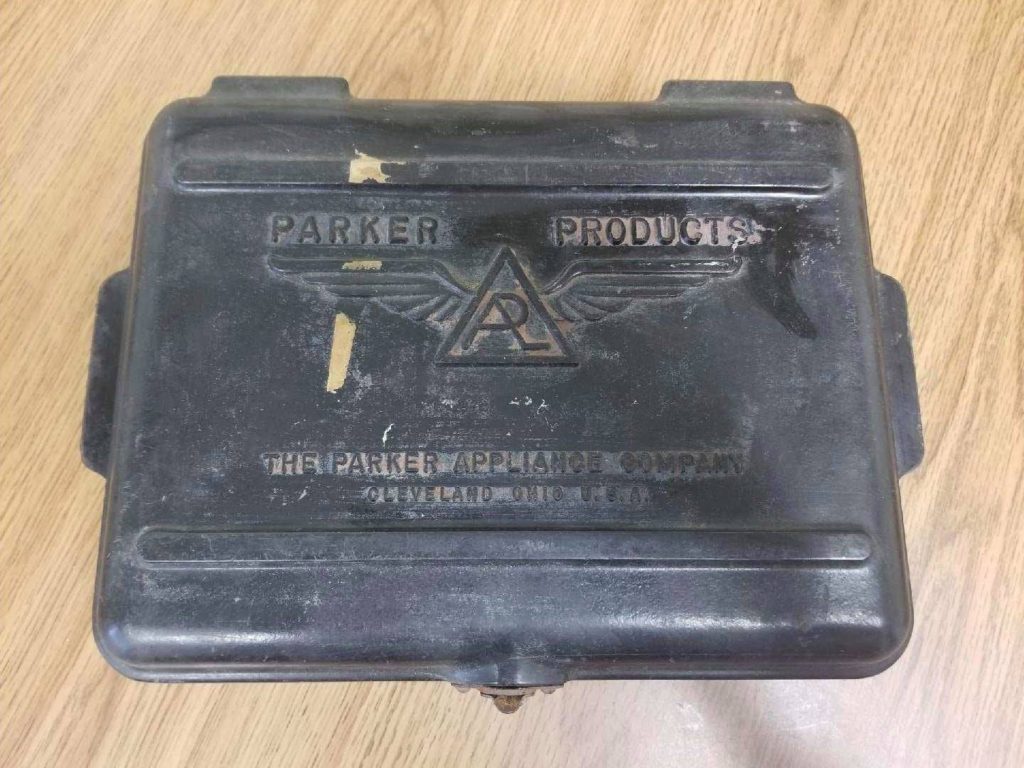
The No. 416 Parker Hand Beading Tool Set.
Photo taken 29 May 2021.
Special thanks to the Gulf Coast Wing of the Commemorative Air Force for inviting Hangar Thirteen to their tour stop at Atlanta’s Cobb County Airport!
Megan and I came down from Aiken, SC and Bob Jacoby up from Jacksonville, FL to meet them yesterday. Lucky Thirteen has long had a close relationship with Texas Raiders (44-83872) and Jarrod Crandell and Kevin Michels have been big supporters, so it was fantastic to finally see them face-to-face.
We chatted for hours and even got the VIP treatment, for which we were totally humbled! My only regret is that, despite taking plenty of pictures of the airplane, I completely forgot to get a picture of us together. Maybe next time – you guys are always welcome.
If the Gulf Coast Wing is in your area for a visit, we heartily encourage you to come out and visit. We think you’ll have a great time. Tell them Hangar Thirteen sent you!
For the latter part of the day, we visited Fred Bieser, who’s place is on the other side of town. Fred was particularly excited to show us his latest acquisition: a rare Luftwaffe turret. We chatted for hours, planning ahead for the needs of Lucky Thirteen, and Bob got to ride in several of Fred’s completed pieces.
All in all, we had a great time.
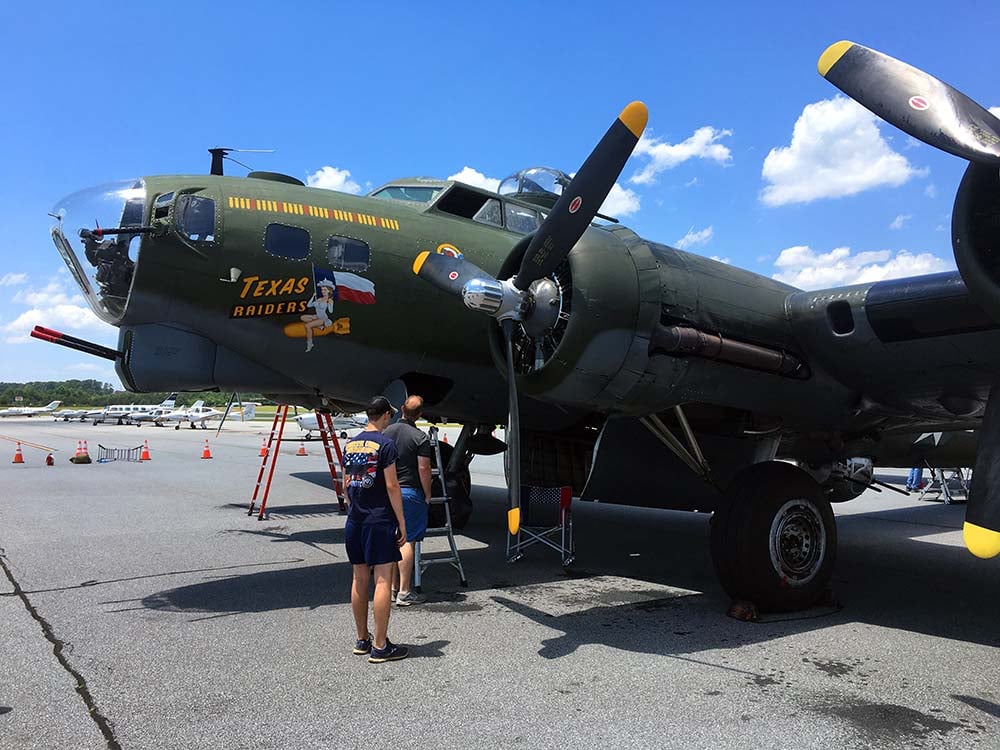
Radial engines do not leak, they leave their mark!
A short lull in the massive crowds gathered to visit Texas Raiders while she was at Cobb County Airport.
Photo taken 26 May 2021.
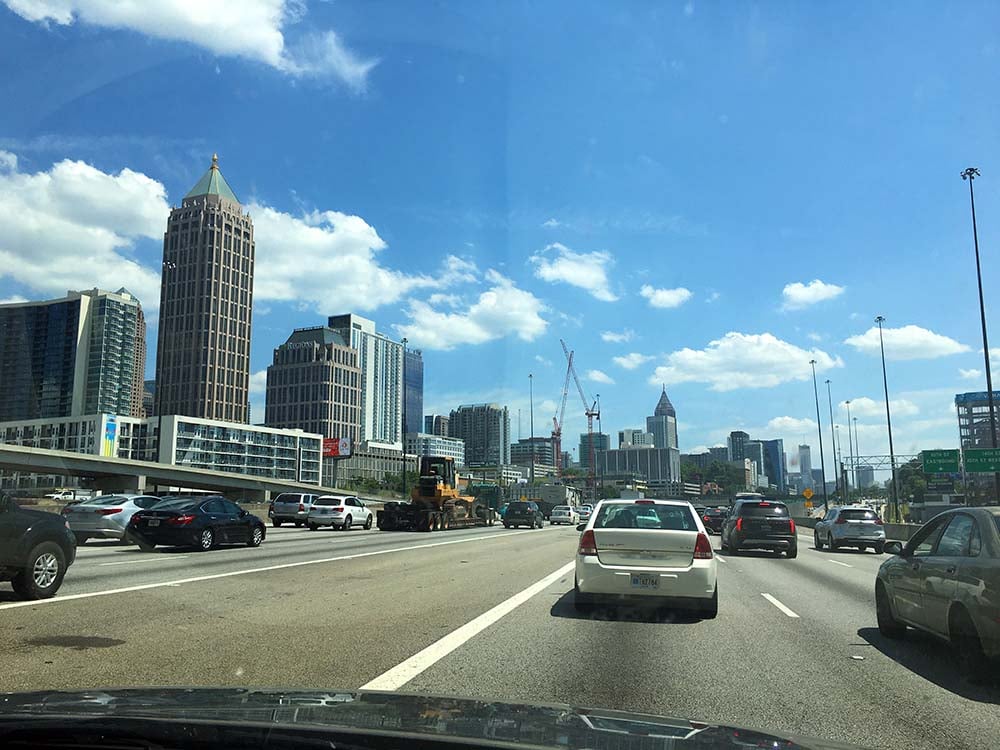
We make our drive back toward the other side of Atlanta. The temperature was 97 degrees (F) and we went through several bottles of water.
Whenever driving through Atlanta, Megan and I always make a special effort to play the theme from “Matlock” on the radio.
Photo taken 26 May 2021.
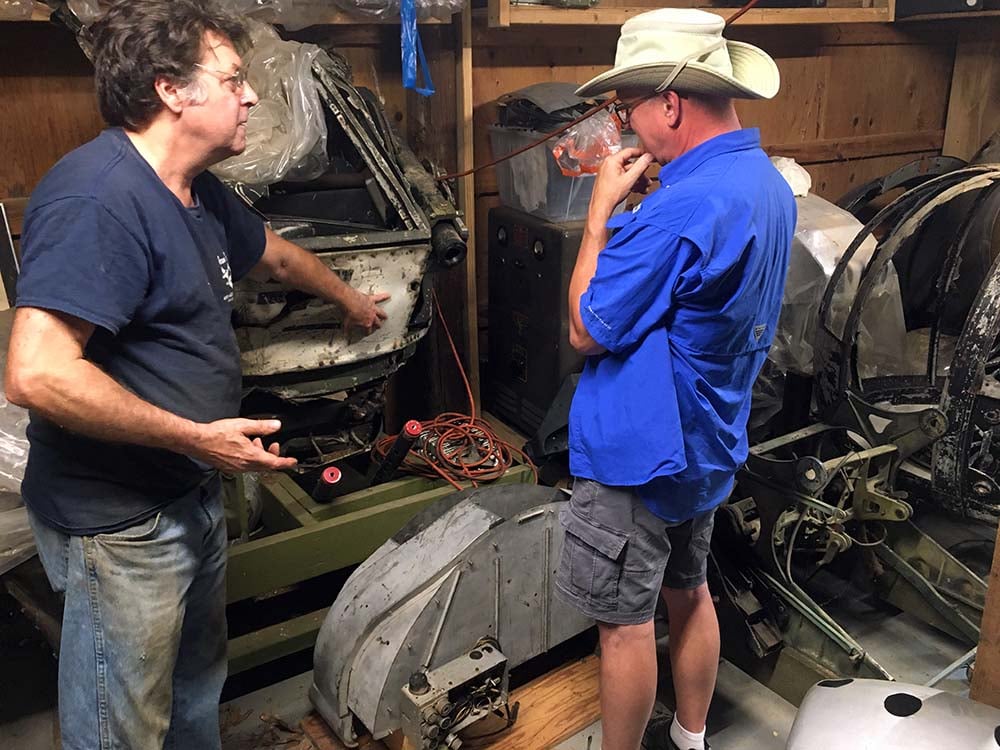
Fred Bieser and Bob Jacoby chat over the markings on Fred’s Type A-6 tail turret (from a Consolidated B-24).
At Bob’s feet is an internal ammo magazine for a Briggs-built ball turret. Covered in plastic in the back is an almost pristine 20mm retractile turret from a Convair B-36. Partially obscured behind Bob is the dome assembly from an RAF Boulton & Paul turret.
Photo taken 26 May 2021.
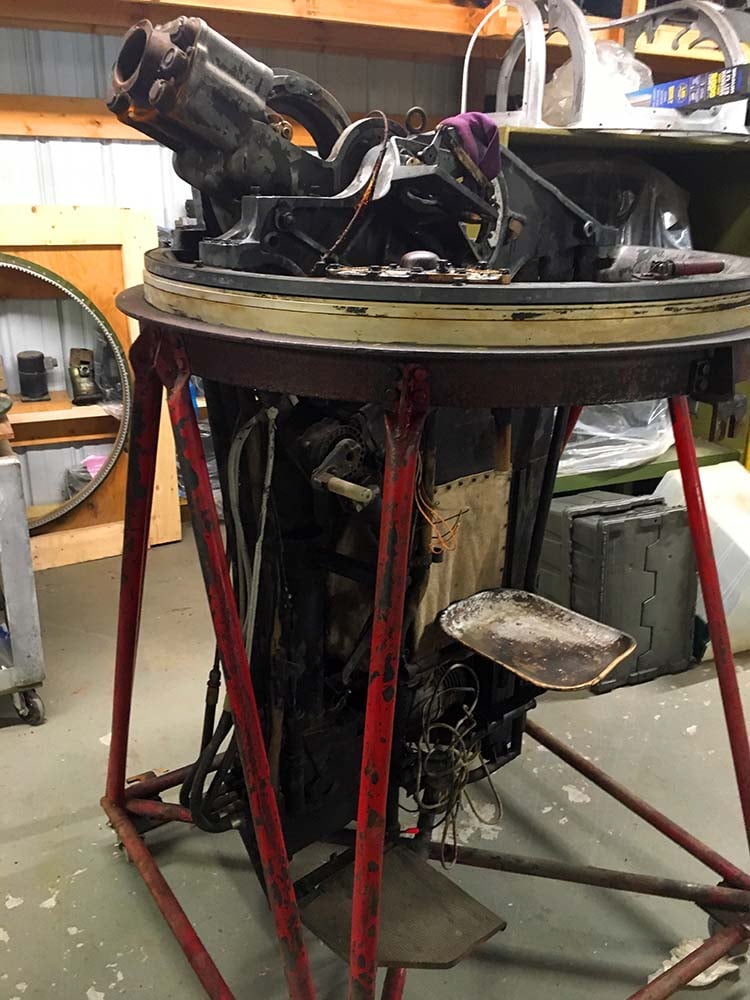
Fred’s latest acquisition – a rare Luftwaffe HD 151.
It is incredibly rare to find a powered turret made outside the US or Great Britain. This particular turret came in two variants: a 15 mm and 20 mm autocannon type. This is the latter. Aircraft which carried these turrets included the Focke-Wulf 200, the Blohm & Voss 138, the Dornier 24, and the Messerschmitt 232.
Photo taken 26 May 2021.
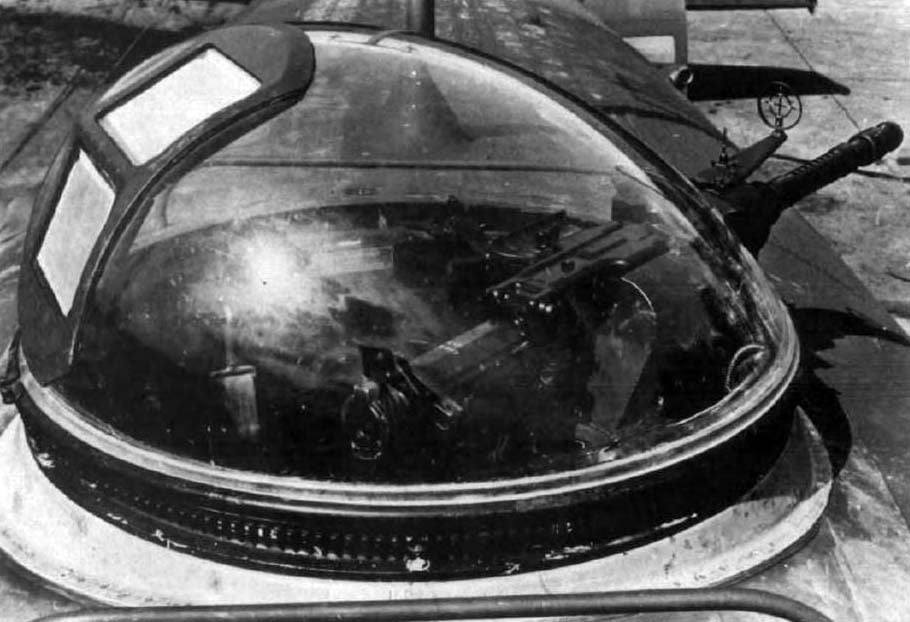
An HD 151 turret installed aboard a FW 200 Condor C-3.
The Condor was a converted airliner which saw heavy service tracking convoys for Kriegsmarine submarine wolfpacks operating in the Atlantic.
There is an effort in Germany to rebuild a Condor – which is sorely needed – using the wreckage of a wartime example. However, this project is focusing their efforts on the Condor’s civilian configuration.
This is one that we have been eagerly anticipating. It just arrived in the mail on 19 April 2021.
These are a pair of yoke caps, donated to us by Luke and John Matthews of West Yorkshire, England. Their granddad was Arthur Matthews, who served in Italy during the war with the 43rd Commando (Royal Marines). Arthur brought back these yoke caps as souvenirs, leaving them to his son Alan after his passing in 1978. Alan passed away last year, leaving the caps to his sons. We are truly humbled and honored that they chose to donate them to Lucky Thirteen.
Yoke caps are some of the rarest and highly prized pieces of aviation history. Little more than tokens symbolizing the aircraft’s make and manufacturer, they were almost always pocketed as souvenirs – which is why they are so rare today.
Made of tenite, these caps covered the screws which attached the steering yokes to the control columns. Initial designs featured the Boeing “totem” logo but were later altered when Douglas Aircraft and Lockheed Vega began building the B-17 under license. These yoke caps featured the Boeing totem alongside the logo the actual manufacturer. A third type, made of aluminum but visually similar to the original design, were produced by Boeing to replace the constantly stolen part.
Since Lucky Thirteen was built by Douglas Aircraft, her cap would have been identical to those contributed by the Matthews family. A truly amazing donation – thank you, guys!
We had hoped to acquire a set of original B-17F control columns in California back in February, but we lost out to a private collector. As such, we sadly do not have a pair of yokes on which to mount these caps. However, around that same time, the guys with the B-17G Yankee Lady (44-85829) were kind enough to donate a pair of mounting brackets for the Matthews yoke caps. They fit perfectly!
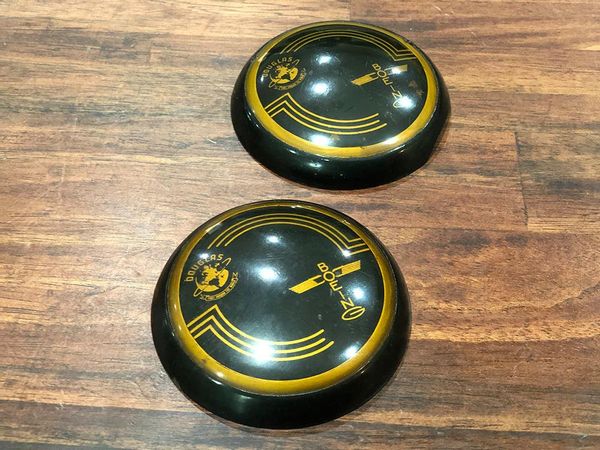
The yoke caps donated to Hangar Thirteen by Luke and John Matthews. Luke has been our contact throughout this process, and it turns out that he is a kindred soul – he restores stationary steam engines, such as those which powered the old mills around Yorkshire.
The area where we are based (North and South Carolina) used to be the epicenter of the US cotton mill industry. Entire towns were built around these mills before they disappeared in the 1990s. In fact, much of Ray’s skills as a metalworker originated from the training he received repairing said machinery.
Photo taken 19 April 2021.
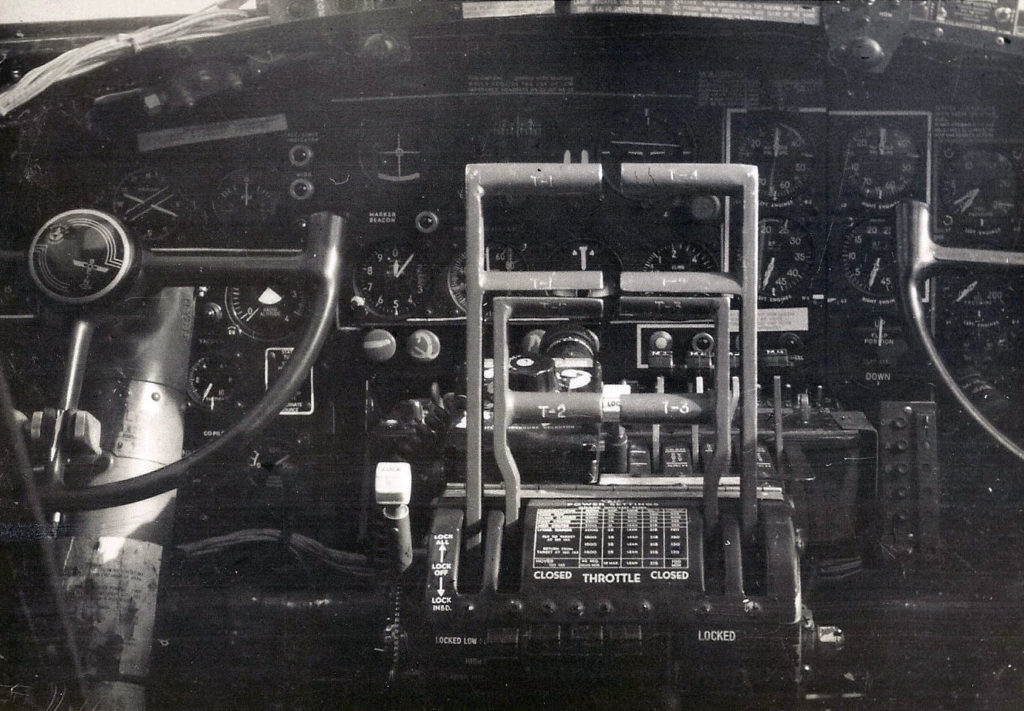
The cockpit of a Douglas-built B-17G. Note the yoke cap visible on the left.
Locating photos of wartime B-17 cockpits where the yoke caps had not been stolen yet was not easy! Thanks Karl!
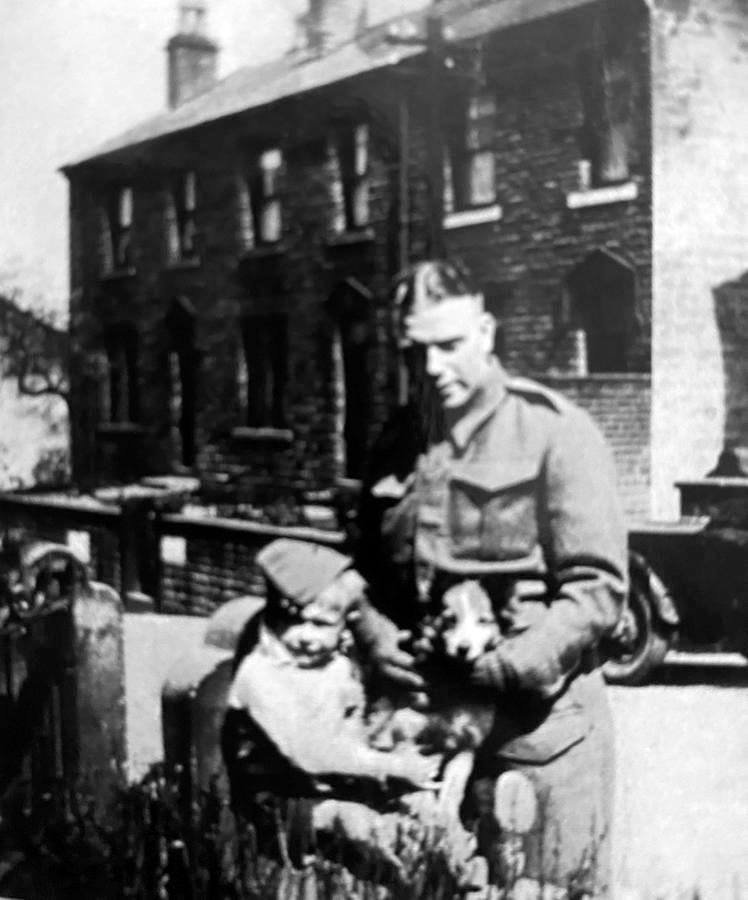
Arthur Matthews with his son, Alan, who was born in 1944. Alan’s sons, Luke and John, donated these yoke caps in memory of their father.
Arthur Matthews served with the 43rd Commando (Royal Marines). The unit was formed in July 1943 – the same month Lucky Thirteen entered service – and saw action in the MTO throughout Italy, Greece, and Yugoslavia.

Commonwealth troops inspect the Douglas-built B-17F Homesick Angel (42-3147, 97BG) at Italy’s Foggia airfield complex (15AF). The aircraft closest to the camera is a Consolidated B-24 and the tail of a Douglas C-47 is visible in the distance.
The Homesick Angel you see here is not to be confused with the Homesick Angel (42-3374) on display at Offutt AFB in Nebraska. Interestingly, the latter Homesick Angel is only a few numbers removed from Lucky Thirteen (42-3455), and as such, is a valuable reference.
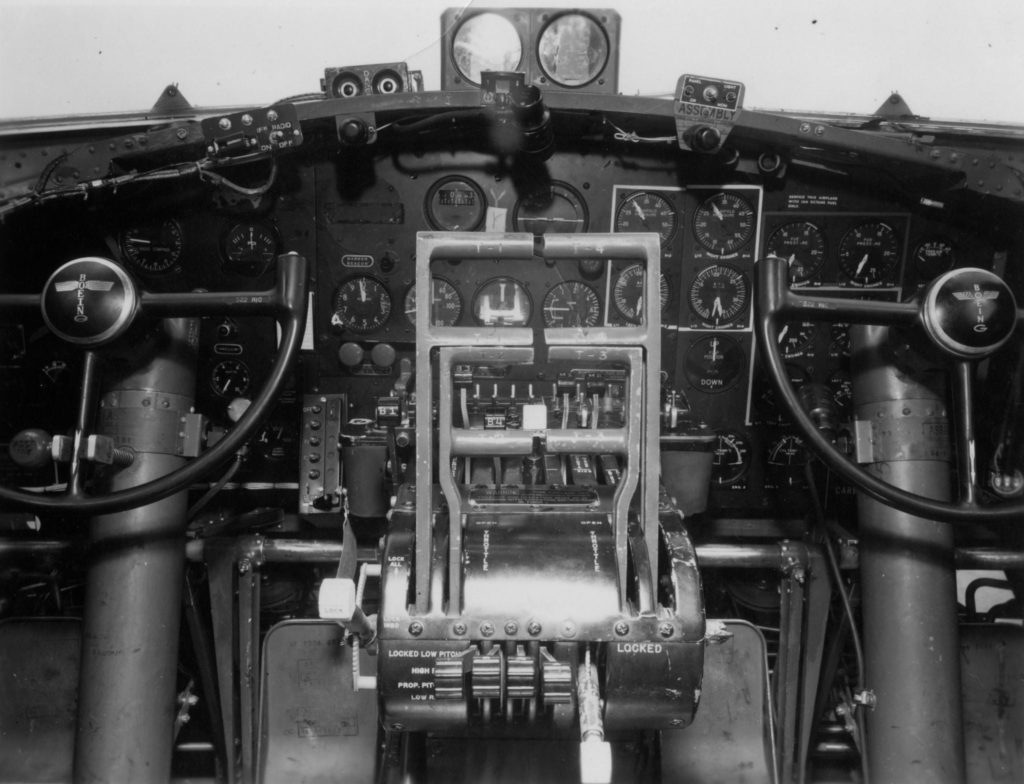
The older style yoke caps as installed aboard a F-model B-17 built by Boeing. The later style replacement caps looked very similar to this design.
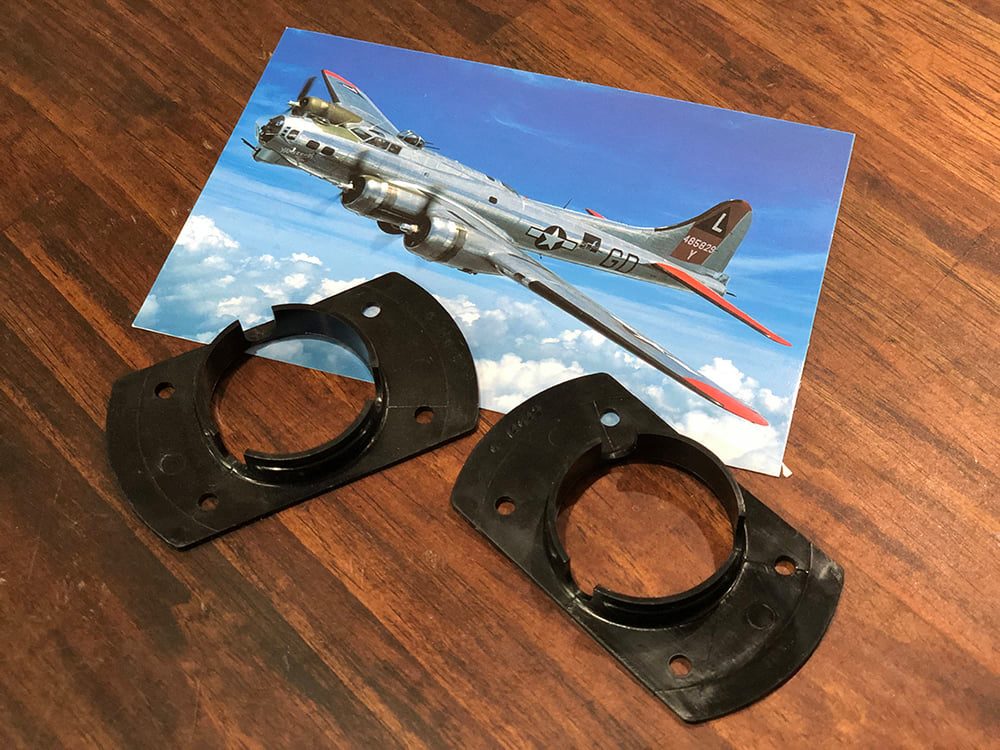
The yoke cap attachment plates donated by the Yankee Air Museum back in February.
Photo taken 19 April 2021.

A common sight – the yoke caps are already missing from this B-17G.
Note the mounting plates on the control yokes, which the caps would have clipped to.
Photo taken 9 February 1944.
Thought I would share this donation from Stan Wolcott of Lucky Forward Militaria in Cody, Wyoming. Stan has contributed components from wartime SCR-578 Emergency Radio Systems, some of which will be displayed in the aircraft (when completed) and some of which will be displayed separately.
The SCR-578 Emergency Radio was built around the BC-778 Transmitter – a yellow, hourglass shaped radio that one squeezed between his legs and cranked like a butter churn. The shape of the transmitter earned it the nickname “Gibson Girl.” The transmitter emitted a distress signal, which was carried via kite or hydrogen balloon, both of which were packed with the kit. Early style “Gibson Girl” sets were stored in a pair of small yellow bags, while the latter type were kept in a single large yellow bag. The earlier variant is correct for Lucky Thirteen.
Our friend Andy Rivera long ago offered to display his “Gibson Girl” for when we have a full museum facility. Andy’s example is a postwar “Gibson Girl,” identical to late-war systems in every way but title. Andy only lacked a parachute and emergency kite for his display. Since we located a kite back in 2019, Stan’s donation of an M-390 parachute makes this display complete.
Early war units did not have a separate parachute; instead, the parachute was kept in a flap on top of the transmitter bag. This is the type accurate for Lucky Thirteen and Stan also donated one such bag.
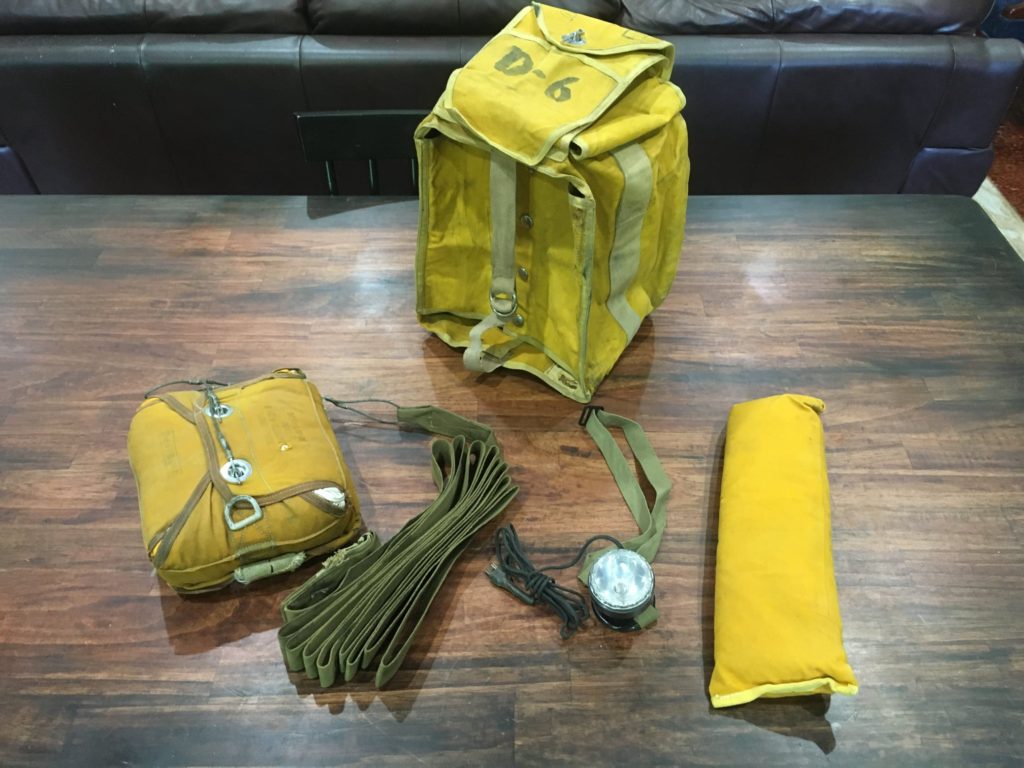
The recent donation from Stan Wolcott of Cody, Wyoming.
Displayed are:
-M-308-A Parachute complete with Static Cord (SCR-578-B/Late-War Gibson Girl)
-BG-110-A Bag for BC-778 Transmitter (SCR-578-A/Early-War Gibson Girl)
-M-308-A Lamp (SCR-578-A/Early-War Gibson Girl)
-Padding for SCR-578-B (Late-War Gibson Girl)
The parachute is missing from the BG-110-A, but that is to be expected. Due to its design, it is doubtful that any surviving BG-110 still has its parachute.
Photo taken 12 April 2021.
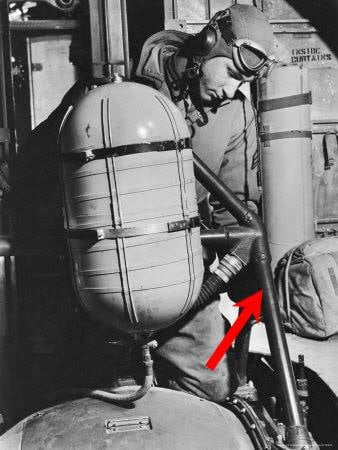
SSGT James M. Abbott, 97BG, adjusts the F-1 oxygen bottle that feeds his aircraft’s ball turret. The two Type A Gibson Girl bags are highlighted with a red arrow.
Note the tall, cylindrical bag behind Abbott – this is the BG-109-A bag we need for Lucky Thirteen.
We have a top turret dome for Lucky Thirteen!!!
Some background:
Hangar Thirteen’s goal with Lucky Thirteen has always been greater than simply rebuilding the bomber – we intend to rebuild her internal systems in their entirety. Recognizing the enormity of that goal, we knew that these systems could not take a backseat to the aircraft itself: we had to start as early as possible. We began with the radio systems, and the progress that Charlie Liberto has made in that area is simply astonishing. But we always knew the armament would be the toughest task.
Restoring and rebuilding gun turrets is expensive, and with the US federal government as bloated as ever, the process of attaining nonprofit status has been LONG. So, in light of that, Chris Wilkinson took it upon himself to kickstart the effort for Lucky Thirteen’s turrets. Almost single-handedly, Chris was able to locate electric motors and hydraulic transmissions for both turrets, as well as spares to use for parts. But the biggest accomplishment of his program thus far is the purchase of a top turret dome.
This Type 1 upper turret dome – correct for a Douglas-built F-model B-17 – was located in 2019 and the process of paying it off began there. The announcement that Hangar Thirteen was able to negotiate the purchase of a top turret base assembly in Belgium (fortuitously timed) provided the impetus to finalize the dome’s purchase. I will not say how much each person donated – just know that these guys went above and beyond for this project. Special thanks are in order for the guys who funded the purchase of this special and unique piece:
Keith Ellefson
Karl Hauffe
Ray Moore
Don Price
Andy Rivera
Chris Wilkinson
So where do we go from here?
Well, the word is “expensive.” The cost of rebuilding Lucky Thirteen’s turrets will be akin to purchasing a brand-new Maserati. We have the skills, we have the knowledge, we have the willpower, and we have an amazing group of volunteers – we just need the funds to get the parts.
For example, we have located a massive ball turret hangar and trunnion assembly. These will have to be purchased. Likewise, we have located internal components for both turrets at a range of prices, the highest so far being a top turret package at $23,000. But the biggest issue will be the top turret’s “tub” assembly and ball turret’s titular “ball.” Both of those will have to be cast brand new.
You can see what I mean by “expensive.” It may be a lot to handle but we can make this happen with your support. Many hands make work light and we cannot do this alone. Kudos to Keith, Karl, Ray, Don, Andy, and Chris – you guys have accomplished something amazing!

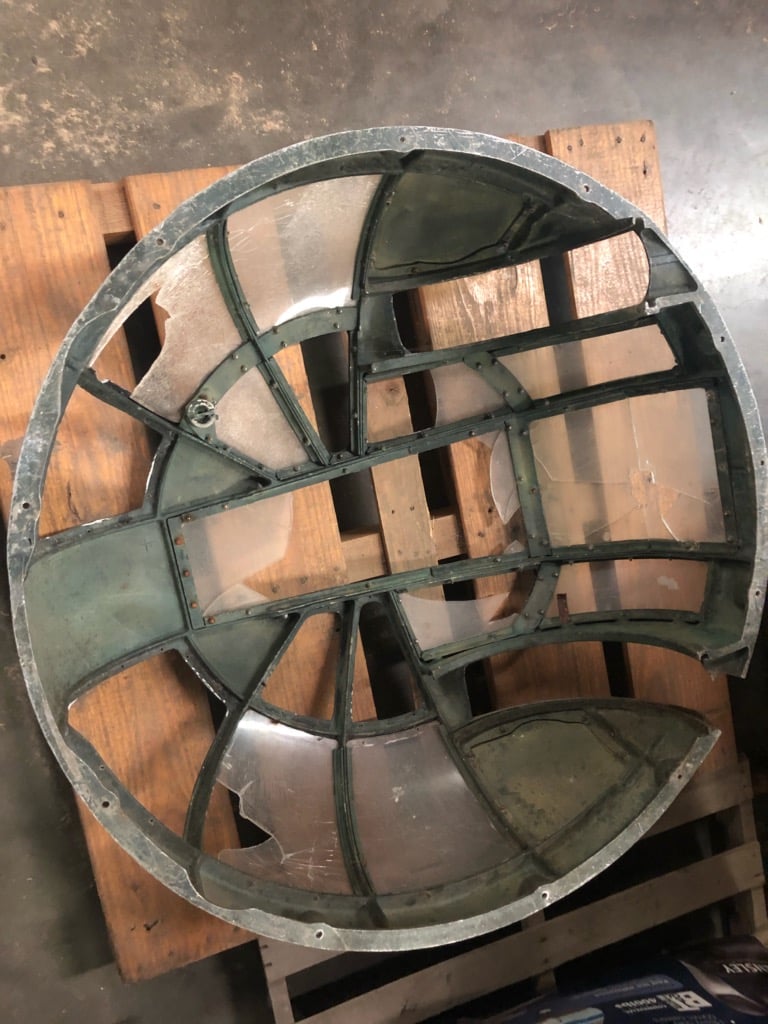
Since this dome has been largely kept indoors and out of the elements, the original paint is in fantastic shape.
The only real issue is the broken piece under the left gun. It does not affect the dome nor will it affect the turret’s operation, but we intend to repair it just the same. Replacing the plexiglass will be more difficult.

A manual illustration is highlighted to show our progress gathering Type A-1 top turret parts thus far. The electric motor and transmissions are shown above as they are not visible inside the turret’s “tub.”
Both of these are variants of the same design. The earlier turret is on the right, having an oxygen tank which must be regularly recharged. The later version has a direct oxygen feed, visible as a bump in the base assembly.

Some things never change – an airmen fills out his aircraft’s flight report while sitting under a Type A-1 top turret. The folder which holds these reports is mounted on the cockpit door.
Note the Type F-1 oxygen bottle folded upward above him – characteristic of Type A-1 top turrets. We have one of these bottles, but need another for the ball turret. If you have any of the top turret’s six ammo cans, and would like to contribute, please let us know!

SSGT Roger D. Palmer (385BG) cleans the guns of his Sperry A-1 Turret, circa September 1943. The dome of his turret is identical to the one purchased for Lucky Thirteen.
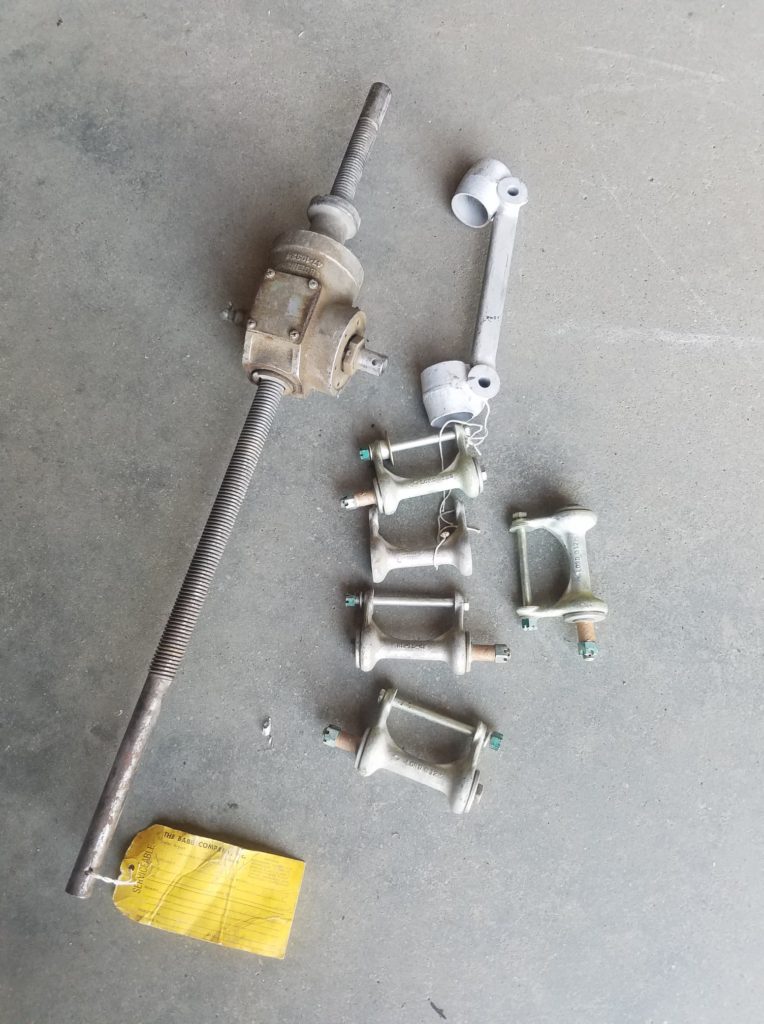
With the announcement made on 10 April 2021 that the turret dome was purchased, 11 April saw our friend Eric Miller of Project Warbird complete a grueling drive from South Carolina to Colorado and back. Eric found some equipment for his Bell P-63 and Cessna L-19, including a super-rare nose gear assembly for the fighter. Eric also brought back some pieces for Lucky Thirteen. The B-17 pieces include a bomb bay door actuator and engine cylinder shock mounts.
Thanks Eric!
